






Everyone has their own motivation when considering making a move into a retirement village.
Some want to downsize, others want freedom from home maintenance. Some are prompted by health concerns and at times, it’s loneliness that encourages people to join a vibrant village community.
For Summerset Waikanae resident, Gavin Archer, it was the vulnerability of living alone that made him think to the future. “In my case, the problem was that I felt a bit vulnerable going forward as a single male living by himself. There was no support there. I thought, perhaps it’s time to actually look to the future rather than hang on to the past,” said Gavin.
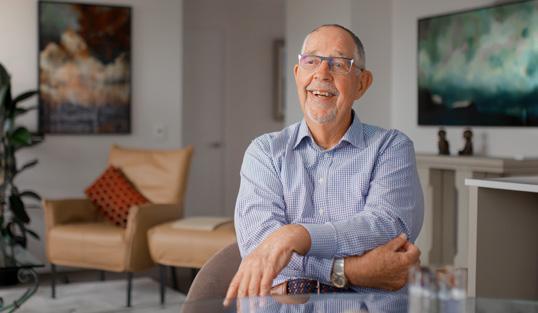
“I had heard about Summerset Waikanae, so I got in the car and drove down here. It was fortunate because the Sales office was a three-bedroom villa, so I could see straight away what a villa looked like.”
“I decided to purchase a three-bedroom villa and it’s great. Summerset has full time presence on the site, day and night. I don’t have to worry about security. I don’t have to worry about anything.
The vulnerability is gone, and freedom has actually taken over from that particular emotion.”
While Gavin has settled into the village, he’s not sitting still. A keen traveller, Gavin plans to continue exploring the world. “I can decide this afternoon to go to Australia tomorrow. It’s just lock and leave and go. If you’ve got your own property to look after, you can’t really do that without planning it. You can’t be impulsive. There’s a big benefit of being able to lock and leave,” said Gavin. “The other big benefit is that the people coming in here, we all come here on the same basis, we’ve got the same aspirations, and I find that everyone meshes together very well.
I’ve got some great neighbours, best neighbours I think I’ve had in the six properties I’ve occupied.
And that’s a benefit because we all come in with the same intention of making sure that the next stage of our life is well catered for.”
“And if in fact something happens, and I’ve got to go into a serviced apartment or other parts of the facility, I don’t lose the identity of the village, which I’ve grown into, or the people. From that point of view, I’ve been quite enlightened by the change, knowing that I’ve got stability.”
If you’d like to know more about the Summerset life, or find a village near you, visit summerset.co.nz
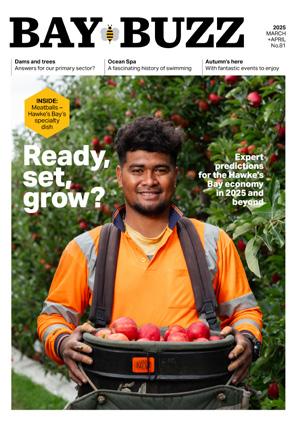
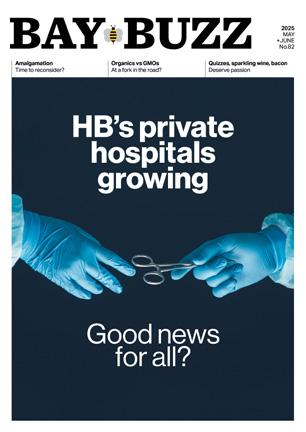
Use promo code MAY25
$10 off for joining ... $59.95/yr
• 6 issues of BayBuzz magazine per year
• 6 issues of BayBuzz Digital version exactly as printed (great for your tablet or laptop)
• All BayBuzz website content
• Free six-month gift subscription for friend
Use promo code MAY25




Use promo code MAY25
$10 off for joining ... $49.95/yr $49.95/yr $14.95/yr $39.95/yr
• 6 issues of BayBuzz magazine per year
• Free six-month gift subscription for friend
$10 off for joining ... $24.95/yr
• 6 issues of BayBuzz Digital version exactly as printed (great for your tablet or laptop)
• All BayBuzz website content
• Mobile-friendly
Get four $10 vouchers to iconic Hawke’s Bay retailers and hospitality hot spots with every personal or gifted subscription to BayBuzz: Beattie and Forbes, Birdwoods, Chantal Shop and Waipawa Butchery.
To pay by credit card or bank transfer, visit our website: baybuzz.co.nz/ subscribe to receive new subscriber first year $10 discount, use promo code: MAY25
May + June 2025

Case for amalgamation gathers strength. HB’s private hospitals expand ... OK? Pan Pac charts sustainability gains. Our food systems heading wrong direction? High cost of local teams competing nationally. A sparkling wine future for HB? Advocating for Napier health services. Meet the Red Queen. HBRC rated worst! Vibrant life at 90. Bacon and quiz addictions.
Follow us at: baybuzzhb
Articles online at: baybuzz.co.nz
Editorial enquiries
editors@baybuzz.co.nz
Advertising enquiries
Mandy Wilson 027 593 5575
mandy@baybuzz.co.nz
Reach BayBuzz by mail BayBuzz, PO Box 8322, Havelock North
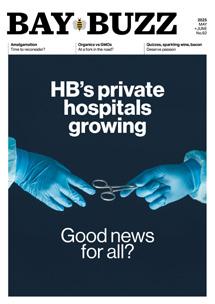
In this article we hear from private and public hospitals about how they work together, and a health systems expert about the increasing role private hospitals are playing.
BayBuzz team
EDITOR: Tom Belford
DEPUTY EDITOR: Lizzie Russell
SENIOR WRITERS: Tom Belford; Abby Beswick; Damon Harvey; Tess Redgrave; Mark Sweet
COLUMNISTS: Prue Barton; Janine Couchman; Rosheen FitzGerald; Yvonne Lorkin; Paul Paynter; Lizzie Russell; Dominic Salmon; Simon Shattky; Jess Soutar Barron; Ian Thomas
BUSINESS WRITER: Brenda Newth
EDITOR’S RIGHT HAND: Brooks Belford
PHOTOGRAPHY: Florence Charvin
ILLUSTRATION: Ruth Mitchener; Brett Monteith
DESIGN: Unit Design - Max Parkes; Giselle Reid
PRODUCTION MANAGER: Giselle Reid
PROOFREADER: Jenny Elliott
ONLINE: Lee Tong
BUSINESS MANAGER: Steph Lowry
PRINTING: Blue Star Group
ISSN 2253-2625 (Print)
ISSN 2253-2633 (Online)
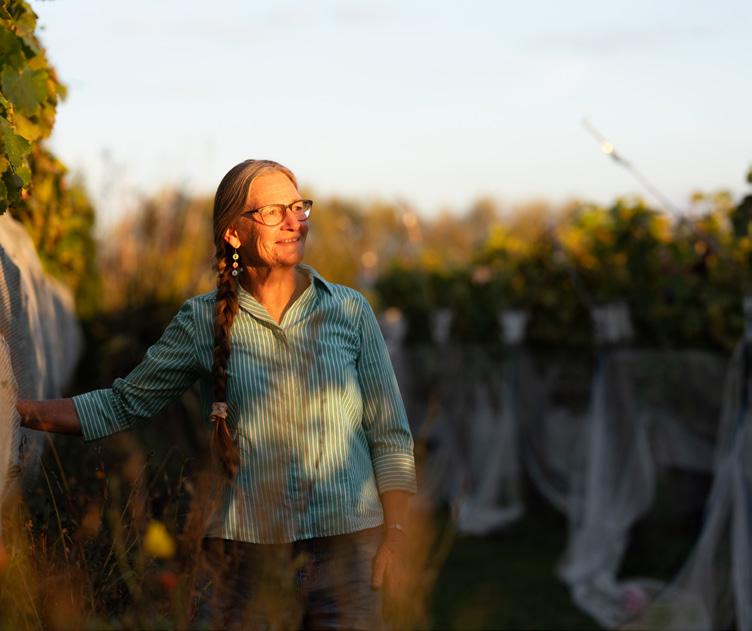
6 From
BayBuzz magazine uses vegetable based inks and environmentally responsible paper produced from Forest Stewardship Council® (FSC®) certified, Mixed Source pulp from Responsible Sources.
Paper produced using Elemental Chlorine Free (ECF) and manufactured under the strict ISO14001 Environmental Management System.
16
Heading to amalgamation?
Tom Belford
Getting serious about local government cost, effectiveness.
22 Pan Pac: “We don’t just grow pine trees”
Tess Redgrave
Pan Pac makes impressive sustainability strides
26 Food for thought
Simon Shattky
Meet Scott Lawson, organic grower & anti-GMO advocate.
30 Flying the flag – at a cost
Damon Harvey
HB teams have talent to compete nationally, but the money?
36 What the doctor ordered?
Brenda Newth
Royston and Kaweka add to local surgical capacity.
44 A sparkling idea!
Tim Nowell-Usticke
Hawke’s Bay needs a breakthrough wine offering.
46 Appropriate healthcare vital for Napier
Mayor Kirsten Wise
The case for better health services for Napier.
48 A waste minimisation plan to lead the way
Dominic Salmon
Hastings & Napier on the right track with waste plans.
50 Which is the worst council?
Paul Paynter
A grumpy assessment of HB local government.
54 Queen of Redness
Yvonne Lorkin
Meet a HB winemaking veteran, Jenny Dobson.
60 How to make a bacon sandwich in under six months
Ian Thomas Can’t imagine a world without bacon.
62 Strong at 90 ... the power of lifelong movement
Janine Couchman
How to live a long, vibrant life.
64 I quiz therefore I am Jess Soutar Barron
Life as a quiz night junkie.
Hawke’s Bay’s primary sector is off to a strong season, with key exports – including apples, squash, wine, meat, and timber – reaching global markets. While we continue to facilitate trade, we are also looking ahead – strengthening regional supply chains, advancing sustainability, and adapting to the evolving demands of global commerce.
Our long-term investments in world-class infrastructure, supply chain efficiencies, and sustainable practices are designed to keep Hawke’s Bay producers competitive on the global stage. We’re focused on both today and the future, ensuring our region’s industries continue to grow, innovate, and thrive for years to come.
Napier Port – your gateway to global markets.

Containers* Exported October 2024March 2025
7,000 3,000 6,000 7,000 18,000

I hope you’ll agree we’ve put together an invigorating assortment of articles for this edition.
Hawke’s Bay politics is already heating up for the local election year and we’ll do our best to stir up the pot.
The region’s councils have made a crucial decision about how water will be managed going forward, opting to propose a new regional entity to handle drinking water, stormwater and wastewater. You’ll have your chance to speak up on this in public consultations before the decision is set in stone. You can further let your voice be heard when you vote in October.
Many voters have been expressing themselves by loudly berating councillors for rate increases across every HB council. For my money, nobody is really serious about rationalizing our local government unless they support amalgamation in some form. So, call me a silly romantic, but my feature article this edition begins to re-surface that mega-issue.
But before we get too far into the election season, BayBuzz is curious about the overall ‘state of mind’ of HB voters regarding our local councils. So, we’re conducting a brief online survey – only 2-3 minutes long – on how you generally rate our councils’ performance. You can use the QR stamp here to access the survey. Please let us hear from you. We’ll report the results in our July/August edition, just as candidates are raising their hands to stand.
Meantime, our health care system is under siege. Demand for services way surpasses capacity to deliver proactive, safe and timely care. While the policy and budget debate rages at a national level – on dollars, changes and pace
– local services must still be delivered on a daily basis.
Mayor Kirsten Wise takes on a local health issue in this edition – HB Hospital’s neglect, as many in Napier see it, of adequate delivery of services to that community.
Why must a mayor champion health concerns? Because local accountability for health care has totally vaporized in the muddle of ‘health care reform’. Our local hospital bureaucracy in Hastings cannot even initiate a media statement on its own (i.e., without Wellington approval), let alone make planning or service decisions that are sensitive and responsive to local needs. So where must a high-profile voice come from ...? HB’s local elected leaders. Hopefully we’ll see more of this from our mayors.
One area where Hawke’s Bay is seeing significant development is the growth of our region’s private hospital capacity. Both Royston and Kaweka are expanding briskly, as Brenda Newth reports in her feature, What the doctor ordered?
No doubt some of you will view this as unhealthy, undermining the public care system and threatening equal access. Others will view it as utterly prudent, leveraging our existing surgical personnel with non-taxpayer facilities investment, enabling our public hospital to do more of the ‘hard stuff’ for all patients. We’d love to hear your views: editors@baybuzz.co.nz
We’ve been covering the sustainability efforts undertaken by some of the Bay’s bigger enterprises in recent editions. This time Tess Redgrave reports on Pan Pac, in “We don’t just grow pine trees” Hawke’s Bay loves its sports, including cheering on our teams competing at the national level ... be it rugby, basketball or football. But our teams struggle with the costs involved, as Damon Harvey writes
in Flying the flag – at a cost
Our latest wine harvest has ended and we’re told to expect a terrific vintage. In her entertaining style Yvonne Lorkin interviews HB’s legendary Red Queen, Jenny Dobson. Whereas in a (sobering?) challenge to our local industry, wine business entrepreneur Tim NowellUsticke proposes a break-through new wine offering to put our region on the global map. No spoiler here!
Speaking of entrepreneurs, Simon Shattky profiles Scott Lawson of True Earth, grower of organic berries and veggies by day, and strong voice in much of the rest of his time against liberalisation of GE for food production in New Zealand, as presently advocated by the Government.
You’ll find the rest of our regular crew in here too – Lizzie Russell, Paul Paynter, Dominic Salmon, Janine Couchman, Ian Thomas and Jess Soutar Barron – with ideas sure to inspire, amuse and/or offend.
Enjoy!

Editor
P.S. Please take our local government performance survey!
Tom has been a two-term HB Regional Councillor. His past includes the Carter White House, building Ted Turner’s first philanthropic organisation, doing heaps of marketing consulting for major non-profits and corporates.

We're planning ahead to ensure our customers and communities in Hawke’s Bay have the power they need to thrive - now and into the future. Tell us what's most important to you and help shape how we power our region for the next 10 years.













In this series, we cast a little BayBuzz light on local treasures – spots you might need reminding about, places to explore in our own beautiful backyard. This issue, we spend an evening in Central Hawke's Bay.
The drive south is gentle, and the greening hills slip past quickly while we chat about autumn and the passage of time, watch the light and shadow move across those hills.
At Millstream Gardens we’re enveloped. By foliage and history and scents and stories and this landscape, but most of all by the Speeden whānau. Jan and Geoff have been here on this land at Pukehou for decades and these days they live and work alongside their son Giles and his partner Rauna and Jan’s sister Viv.
They’re warm hosts, taking us to stroll the lush, diverse gardens, check out Giles and Rauna’s beautiful tiny home, meet the sheep, and hear about the history of this land and the development of this business.
The Speedens are delighted and excited by plants, enchanted by the magic of growing things, full of gratitude for this place and this work. Most of the plants used in the Millstream natural herbal ointments and skincare products are grown right here and it truly is a cottage industry, with everyone having areas of expertise and then pitching in together as needed. Collaboration and co-operation. Companion planting both inside and outside.
In recent months there’s been a separate focus in the form of an art exhibition down the road in Waipawa at the museum. The family have brought together over fifty artists from around the region for Unpacking the Too Hard Basket – An examination of how we engage with Nature. It’s our next stop, where we meet and chat with curator and manager Jana Uhlirova. The exhibition presents a conversation about the environmental issues we’re
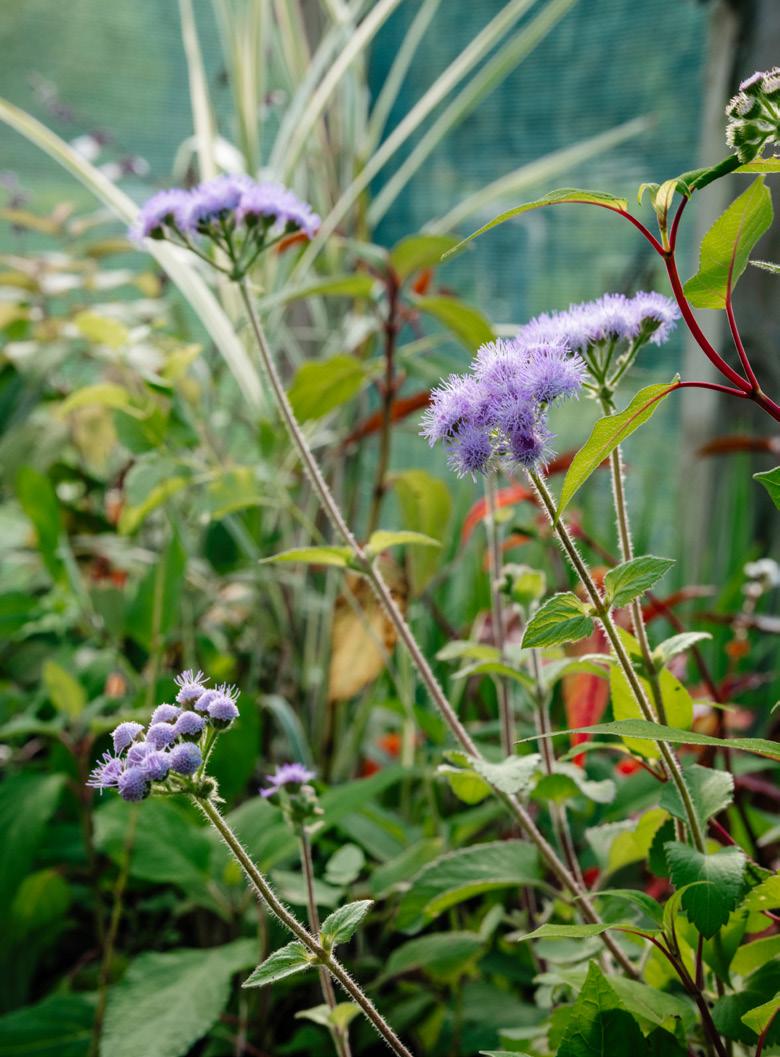
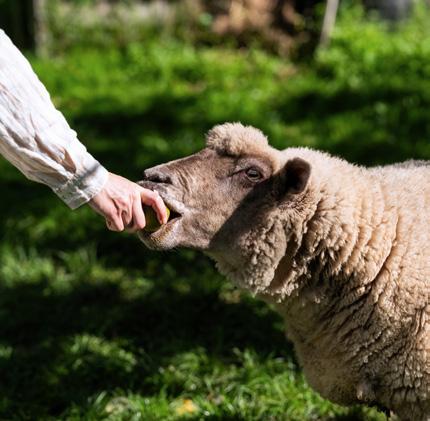
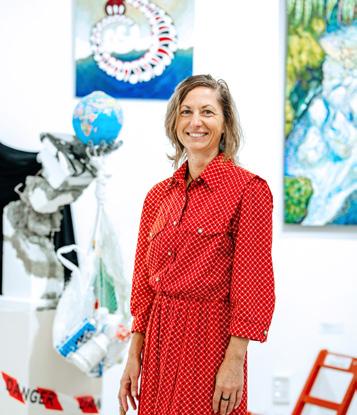
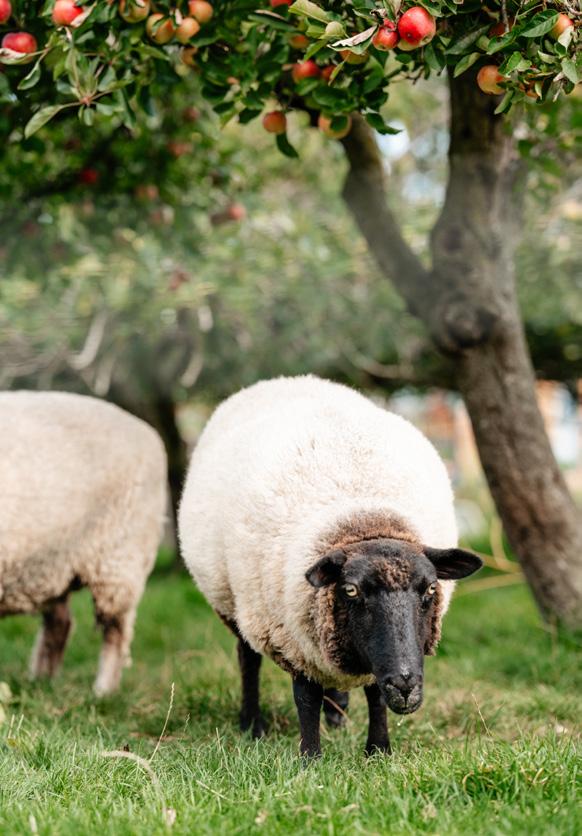
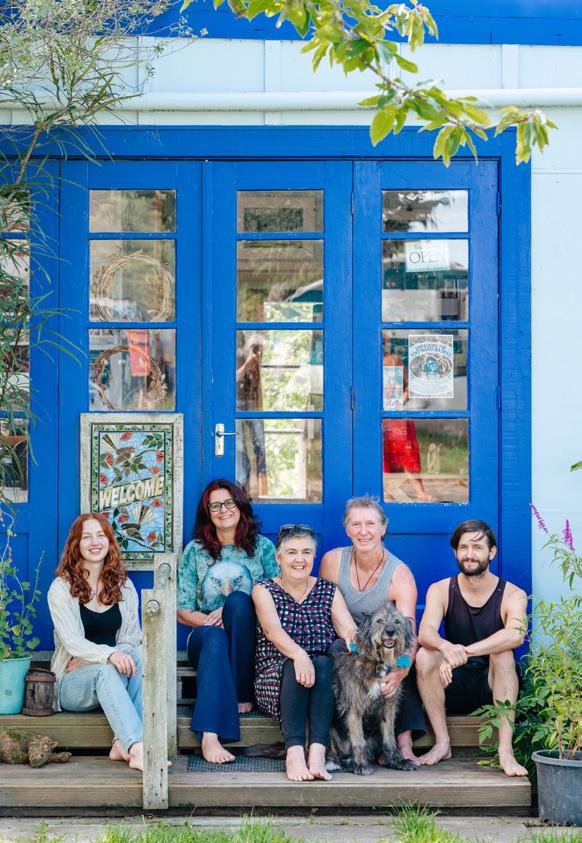
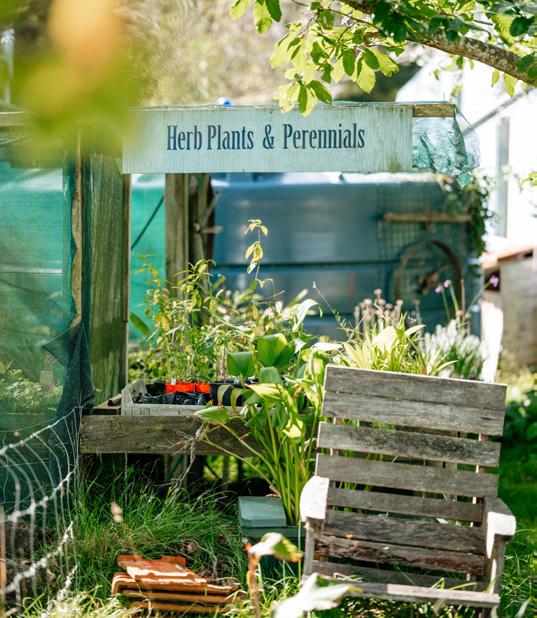


facing and the rapidity of humanity’s impact. It features works in a mix of media by a range of artists, from high schoolers and emerging makers to established practitioners. The pieces are thoughtprovoking, some surprising, many of them beautiful. All of it a great reason to visit the CHB Museum. Giles’ video at the beginning of the show should be compulsory viewing. Late afternoon we’re heading north again and feel drawn to stop at Pekapeka. More light and shadow on those hills. More autumn and the passage of time.
Millstream Gardens products are available online and in local retail stores (listed on the website millstreamgardens.co.nz), or you can pop in for a visit to shop. (Call first to make sure someone is there to greet you.)
The exhibition Unpacking the Too Hard Basket is open to view at the Central Hawke’s Bay Museum in Waipawa until May 30th. Artworks are for sale and entry is free. Pekapeka Wetland is always there for you to take a stroll around, and it’s an easy 10-15 minute walk. Stop and stretch your legs the next time you’re heading north or south.

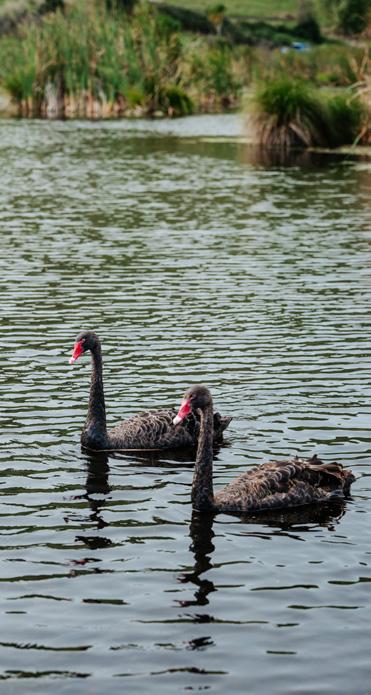
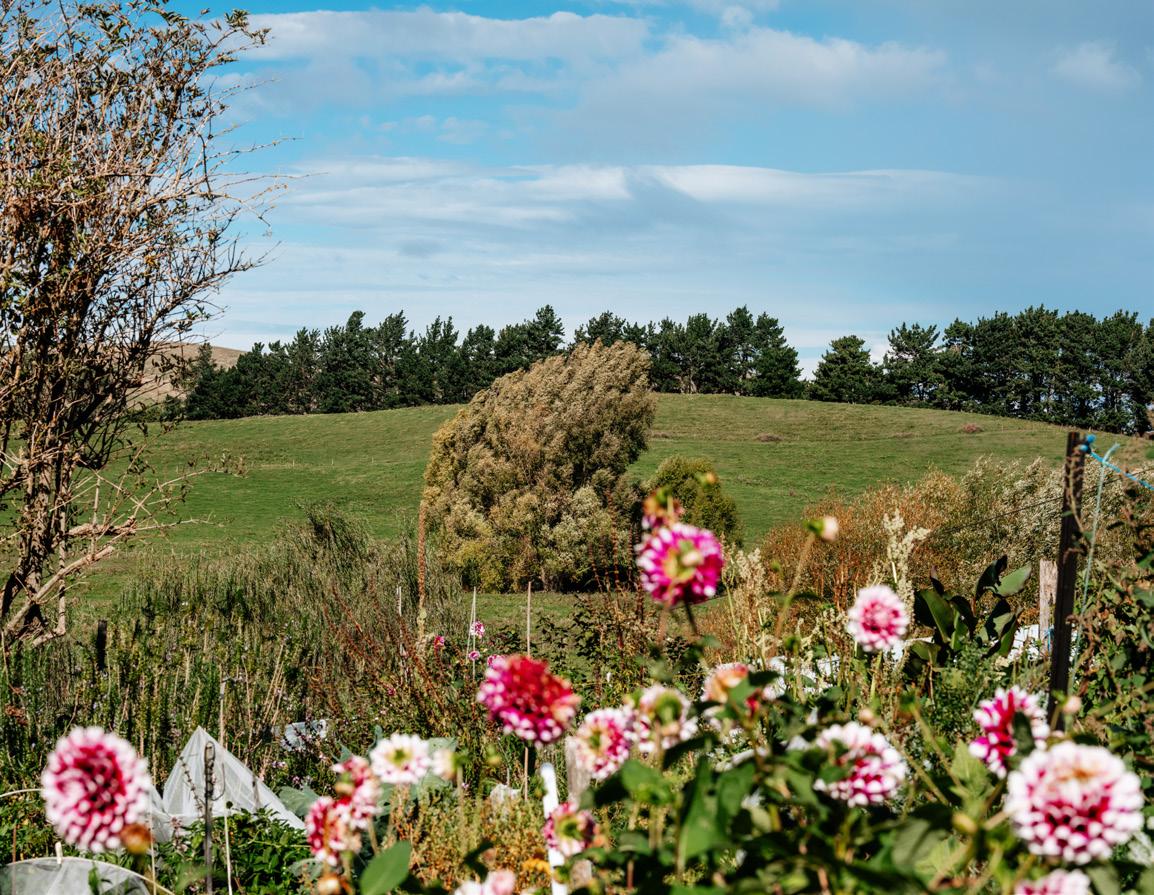

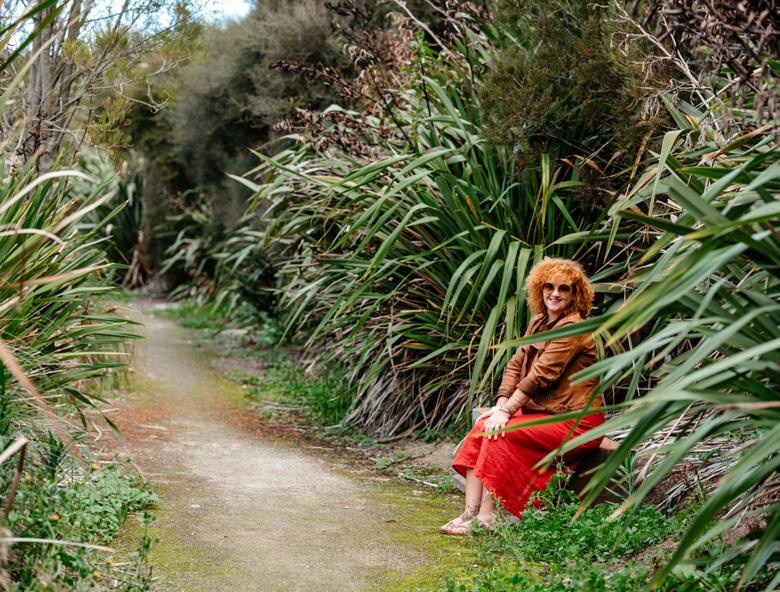

of chronic diseases are preventable with early recognition of health risk factors.


Don’t let streaming platforms, seasonal affective disorder and general cool weather glumness take over as we head deeper towards winter. There is much to get out and about for. Here are some picks for keeping chipper as it gets chillier:

Late May sees a four-stop tour of “Unsung Heroes” a treat of music and storytelling, featuring four NZ musicians accompanied by renowned journalist and broadcaster Cameron Bennet and actor Peter Elliot. Make sure you’ve signed up for the email newsletters to hear the latest on who else is coming and to which sweet, rustic small hall next.
While the elections for city, district and regional councils aren’t until September, we can expect to see a ratchetingup of action from candidates wanting to connect with the voter base. Keep an eye on council websites and social media for dates and details, and then get along and ask questions about how your rates are being spent and the region is being managed. Hey, better still, you could run for a seat! See your local council website for details on how to run. Nominations open in July.


Seaside cocktails and ice-creams Mix’d has just opened at Ahuriri, where Hot Chick was for decades. The best and beachiest location in Napier plus cocktails – what a combination! Plus, there’s Scoop, a new icecream parlour right next door (where Cool Cat once was), serving up Rush Munro’s and open till 8pm.

This year Matariki falls on 19-22 June, marking the reappearance of the constellation. The public holiday will be on Friday, 20 June. It’s time to reflect, connect and look to the future. There will be plenty of events on and around the long weekend, including the return of Matariki Mahuika Beach Fires along our coastline.
There is no need to go to Noosa or Bali or Tuscany or California to experience something new this autumn or winter. Live in Havelock? Head to Ahuriri and check out the Globe Theatrette and have Italian at Casa. Reside in Napier? Try FunBuns and Hastings Distillery in the East 200 Block over in Heretaunga. Take a ride on a Hawke’s Bay Trail on the other side of the river. Go wine tasting and hear all about the magic of the 2025 vintage. Walk on the salty sand at Waipātiki or Waimārama or Pourere or Pōrangahau. Have a cold dip. Have a wander around MTG Hawke’s Bay. Have a beer at Brave or Giant or Three Wise Birds. Walk up Bluff Hill or Bell Rock. What a spot.
B u b b l e with JET® L a v i s h T e c h n o l o g y


Offer available in store only from 1 May 2025 until 30 June 2025 15% of f
In looking at New Zealand’s response to climate change, it’s instructive to compare the actions of the Government to some of our biggest corporate players.
Alongside all other nations, the NZ Government is responsible for setting the country’s official emissions reduction target – the Nationally Determined Contribution (NDC) – a procedure established under the original Paris Agreement.
As I reported last issue, Climate Minister Simon Watts set the NZ commitment at reducing emissions to 51-55% below 2005 levels, which is only 1-5% above the current NDC of a 50% cut by 2030. A bad joke.
Advice from the NZ Climate Commission was that emissions could be cut 66% without constraining our economy, putting NZ more in the range of other nations.
While our Government is treading water on climate, major NZ business enterprises are moving forward.
Take for example, Fonterra, which some might find surprising. But as NZ’s leading exporter, Fonterra competes in the global marketplace and is alert to the expectations of the real-world. Those expectations – demands actually – include sustainable, traceable food production practices.
So, Fonterra will be paying its dairy suppliers a premium for low emissions production, while the likes of Federated Farmers shrieks in the ear of a captive Coalition Government about emissions reductions wrecking the farm economy.
From 1 June Fonterra’s farmers will be eligible for payments of 1c-5c a kilogram of milk solids if they meet
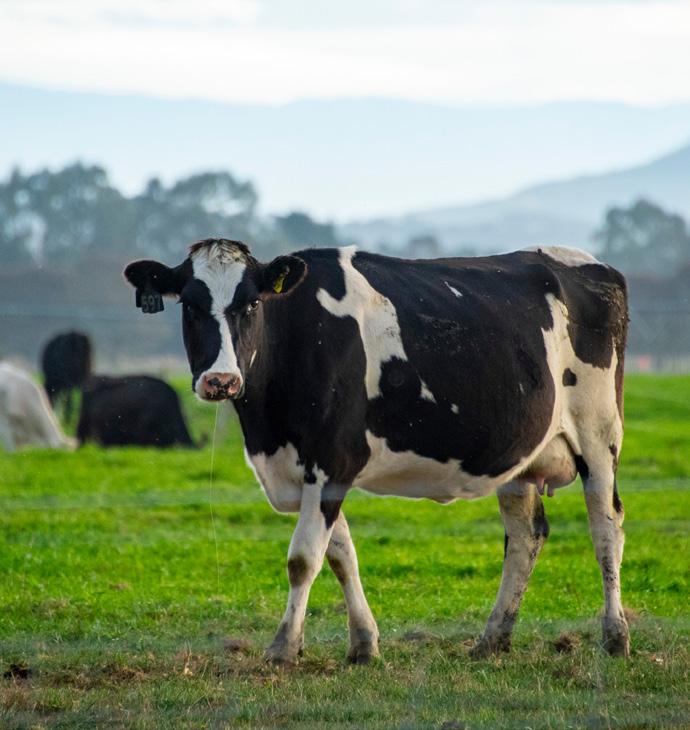
certain emissions criteria – 5,000 farms are estimated to be eligible for the payment. In addition, suppliers with the lowest emissions will receive an incentive payment of 10c-25c a kilogram – about 300-350 farms are expected to be eligible.
And where is the funding for these incentive payments coming from? Fonterra’s customers Mars and Nestle!
Announcing Fonterra’s latest financial results, CEO Miles Hurrell commented: “We believe that long term there is value to be had in following those customers that are growing on the back of their own sustainability credentials.”
This is the real-world speaking ... and setting the future terms of trade.
Let’s look at another real-world example in New Zealand.
This involves another familiar corporate, Genesis Energy, NZ’s largest electricity and natural gas retailer ... and one that on occasions of peak demand and/or periods of low hydro and wind must burn a heap of coal. In FY24, due to a shortage of hydro and wind generation, Genesis needed to burn coal that produced 1.2 million tonnes of CO2 emissions more than the previous year.
The resultant electricity price spike
shut down Winstone Pulp, a customer worth 7-8% of Napier Port’s export earnings.
Genesis CEO Malcolm Johns wants to replace that coal use with biomass. “Under our new strategy Genesis is pursuing biomass at some speed, investing in a dedicated team to deliver real outcomes at volume,” he says. Specifically, use 300,000 tonnes of biomass fuel to replace its coal generation by 2028.
So, Genesis recently signed a MOU with Hastings-based company, Carbona (an offshoot of Polytechnik), to build a facility that will turn woody biomass into high-energy ‘torrefied’ pellets.
Torrefaction is a proven technology for super-heating wood (and other biomass) in a low-oxygen environment, removing moisture and volatile compounds, producing a dry, energy-dense product referred to as torrefied biomass. The process itself generates the energy to meet its own energy requirements, so it’s carbon neutral.
Genesis has trialled the process already at smaller scale and is now looking to scale up with Carbona. The Central North Island plant to get this started will be one of the biggest in the world.
Carbona’s David McGregor estimates the NZ market for industrial use of substitute torrefied pellets is 800,000 tonnes per year. But to Carbona, this is just the starting point. Other major NZ
user industries, including dairy, meat, steel and cement – all needing to address electricity prices and emissions footprints – would readily lift the domestic market to around 1.5 million tonnes, which is ample scale. Internationally, the market would be in the tens of millions.
In a forest-rich region like Hawke’s Bay, Carbona is confident they could stand up an economically viable plant fuelled by 180,000 tonnes of wood waste. Recent analysis indicates that waste supply is readily available in the region (600,000 tonnes).
Torrefied biomass produced in Hawke’s Bay could be used as a gas substitute for industrial boilers locally or for export, either to the South Island (substituting for coal) or overseas … a prospect Napier Port might find enticing.
While the corporate world forges ahead on climate action, and NZ’s central government drags its heels, our HB councils spin their wheels.
BayBuzz has complained repeatedly about lack of action from the region’s Climate Action Joint Committee. Some of its participants seem to agree.
Deputy Mayor Annette Brosnan led the charge on Napier City Council’s recent withdrawal from the Joint Committee. She referred to that committee’s “history of underachievement”, adding: “Instead of waiting on a committee that has struggled to deliver meaningful outcomes, Napier should be taking ownership of its climate future, elevating reporting and climate importance, focusing resources where they will have the greatest impact.” And in fact, NCC does have an impressive climate action plan.
Subsequently, the Wairoa District Council also resolved to withdraw from the committee.
Mayor Craig Little commented: “While our Council has committed to continue to collaborate on regional climate action initiatives, we also need to focus on Wairoa specifically and are pursuing offers around how we can achieve this, which includes less cost and more up-todate information.
“HBRC is the regional unitary authority and should be doing the work of the Climate Action Joint Committee, in discussion with the Hawke’s Bay councils.”
In the aftermath HBRC Chair Hinewai Ormsby and colleagues kicked the matter to touch until after the October election, announcing: “The Mayors of the region and I discussed that it makes sense to continue to the end of the term to complete particularly the Climate Change Risk Assessment report and its engagement with our communities across the region, and that any changes to the Committee and its work can be set in the new triennium.”
I agree with Mayor Little, HBRC should do the heavy lifting on planning the regional strategy, conferring along the way with other councils on how their internal work is progressing and what their role in the regional plan should be.
And yes, the climate crisis will still be here in October.

BayBuzz energy and climate reporting is sponsored by Unison in support of independent local journalism. Any editorial views expressed are exclusively those of BayBuzz. Unison is not associated with those opinions.
Dental implants have been around for a long time in dentistry. Today, they are still considered an optimal option for replacement of missing teeth.
THE REAL DENTAL BENEFITS OF IMPLANTS ARE:
• Looks and feels like a real tooth
• Very stable, can be used for chewing just like a real tooth
• Long term solution
• Conservative treatment as adjacent teeth are not altered
• Can be used for single tooth or multiple tooth replacement
An initial assessment is needed with your dental professional. This will ensure that you have adequate bone support to have a dental implant.
The dental implant can then be placed under local anaesthetic and not long after, you will have a natural looking tooth in your smile
92 Te Mata Road, Havelock North

Within Hawke’s Bay’s five councils, the dirtiest word one can utter is ‘amalgamation’.
That’s particularly true of elected councillors; rumour has it that at least some council senior staff, operating in the trenches, feel otherwise.
In any event, a number of forces are at work that might put amalgamation back into play for Hawke’s Bay, whose voters roundly defeated the proposition ten years ago.
Let’s take a look at the new political landscape and the forces at work.
Central government ‘regionalisation’
The current Government has several initiatives underway that are pressing local councils to unify, not just in spirit, but structurally. Or that will curtail some key current responsibilities of local councils.
Most obvious is the expressed preference of the Government for councils to regionalize their approach to delivery of water services – drinking water, stormwater and waste water.
Local water done well
In simplest terms, to relieve current borrowing constraints on councils and capture economies of scale in service delivery, the ‘preferred’ option
of the Government under its ‘Local Water Done Well’ framework is to see councils agree to create a new regional entity that would charge for and deliver water services, taking this function off the back (and balance sheets) of our local territorial authorities. Our councils have until September to declare their course of action.
As I write, three of Hawke’s Bay’s councils – Hastings, Napier and CHB – have signaled their preference to ‘go regional’. Odds are that Wairoa will join the party, given that it has zero prospect of funding its needed water infrastructure on its own.
This is a huge set of operating responsibilities to take away from local councils, although they will still be involved in governance of the new regional entity.
Then there’s RMA (Resource Management Act) reform, another cornerstone overhaul undertaken by the Government. As presently signaled in Cabinet papers and public discussion, the Government proposes to ‘simplify’, reduce and/or remove a significant number of local government activities related to consenting and environmental management.
For example, water quality standards would be set centrally rather than by the Regional Council and under consideration is creation of a national agency to monitor and enforce environmental rules. Obviously, this would remove a key function and budget requirement of the Regional Council. As a recent Cabinet paper on RMA reform observes:
“This, combined with other system changes (ie, national standards and zones), would involve a reduction in the role of local government, which if progressed would have wider implications for the structure of local government in New Zealand ...
“We recommend the Minister of Local Government and the Minister Responsible for RMA Reform come back to Cabinet later this year, if needed, with details of potential local government reform as a result of these changes to the resource management system ...
“The new legislation will include provisions relating to the roles, responsibilities, and processes of local government, including proposals that will differ from the status quo under the RMA for some matters. However, resource management reform will not be the primary vehicle for local government reform. Further advice will be developed on the interaction between resource management and local government reform.”
Under the new RMA legislation, consenting around building and housing would also be reduced, both through national standardization of the relevant rules (e.g. building height limits) and sharply limiting the instances where private property development would require council approval. As the ‘property rights first’ Cabinet paper puts it: “...land use effects that are borne solely by the party undertaking the activity would not be controlled.”
Overall local planning would be unified and simplified, with councils mandated to collaborate in creating one regional master plan, containing
A Planning Act chapter managing land use for each territorial authority within a region
A natural environment plan chapter for the region delivered by the regional council Goals and principals
‘chapters’ – one on spatial planning and one on natural resource use. See the adjoining chart for how this all is supposed to fit together.
These again are activities that consume significant council resources. A Regulatory Impact Statement evaluating the proposed changes estimates savings of $14.8 billion in administrative and compliance costs over 30 years. Some of this of course being charges that would normally fund the councils’ consenting staff and processes. According to the Statement, this would be a 45% improvement in administrative and compliance costs when compared to the current Resource Management System.
At the same time, the Government is holding out the ‘carrot’ of “Regional Deals”. In this scheme, if councils come forward with regional plans for housing and other infrastructure investment, the Government proposes to combine the relevant existing central government funding pots, give funding certainty for longer periods, ensure the coordination of the relevant central agencies, and give the local authorities more flexibility as to how to actually spend the funds to meet their objectives.
Here is how Infrastructure Minister Chris Bishop enthuses about ‘Regional Deals’: “Those are long-lived partnerships between central government and local
government, setting out a plan for a region over 10, 20, 30 years, saying: ‘Righto, as a region, you’ve got these priorities; as a central government, we’ve got these priorities; let’s get some agreement on what those are, let’s get some funding structures in place, let’s map out the region, spatially plan the region – particularly around housing and major transport, major industry and things like that – and let’s get the funding structures in place to make sure we can go ahead with that. And that is extremely popular with local government.”
So far, the Government has been adamant that this approach doesn’t translate into additional
funding. As PM Luxon cautioned Local Government NZ last year: “I’m sure that will be very popular among councillors, who want to spend money without raising rates to pay for it. But if any of you think those will be the terms of a regional deal, it’s time to come back to reality.”
But, still, a strong incentive for local councils to act regionally. And HB’s councils have done just that, having submitted their proposal earlier this year for a Hawke’s Bay Regional Deal (contents confidential under Government edict).
Finally, while these major initiatives are in play, the Government has made other noises about limiting the scope of local council activity. Ministers have commented, for example, on capping overall local rates levels and legislatively directing councils to focus only on ‘core’ activities.
Here’s Minister Simeon Brown introducing his local government reform legislation, which includes removing the so-called ‘four well-beings’ (social, economic, environmental, and cultural) in the current Local Government Act: “Evidence shows that including the four well-beings in the Act led to about two per cent higher rates growth each year. Removing them sends a clear message that councils must focus on roads, rubbish, and reliable infrastructure.”
And back to PM Luxon: “We do want to work closer together – and there will be new revenue tools for councils, where that makes sense – but the days of handouts are over ...
“Yes, councils need adequate revenue to fund core responsibilities like roads, rubbish and water, but the value-for-money proposition is more questionable in a range of other areas ... Councils need to examine those areas more closely, and I’m up for any tool – like revenue capping – that makes them do so.”
Does this sound like a Government keen to see 78 local and regional councils perpetuated in New Zealand?
In the meantime, here in the Bay, band-aid efforts to regionalise our council efforts in various critical areas have been mostly floundering.
Cyclone Gabrielle triggered a deluge of criticism and reform recommendations regarding our emergency preparedness and management capabilities. Even getting mayors to officially declare an emergency was a bureaucratic ordeal. Now
we have a freshly energized HBCDEM overseeing plans for more effective planning and coordination.
Related, we’ve had a Joint Committee developing a coastal hazards strategy for over a decade. Excellent technical work has been done. But although a sensible funding structure developed by an outside advisor has been signed off in principle (with HBRC collecting from ratepayers), agreement is yet to be officially consulted on, approved and implemented.
We’ve had a regional Climate Action Joint Committee for several years, whose charter is to develop a regional strategy for mitigating and/ or adapting to climate change. But in recent months, both the Napier City Council and the Wairoa Council have announced they are pulling out, each discontented over lack of output from the joint exercise. The five councils have now quietly agreed to do a stocktake on this venture after this year’s local elections.
Our new Regional Economic Development Agency (REDA) lasted barely two years before its Board and CEO resigned in April. A Review of Regional Structures Report declared that a different approach to the region’s economic growth needed to be taken. The new approach is a “refreshed delivery entity” (still called REDA) with a new team to be installed by next April. Its mandate: “... includes advocacy, convening, policy/analytical and commissioning capability as well as senior-level expertise with regional mana, able to bring a focus to regional needs across economic and social strategy and the ability to engage effectively with decision-makers (in particular central Government).”
Exactly what would be expected of a decent unitary regional authority. But alas, Hawke’s Bay soldiers on with five councils instead.
Loosely bound together by the Matariki Governance Group (MGG).
The MGG is what passes for regional governance in Hawke’s Bay. It consists of the region’s mayors, HBRC chair and a collection of Māori leaders (NKII and six Post Settlement Governance Entities). It’s bound by no rules – open meetings and Official Information Act requirements don’t apply. It hasn’t had a website in years. It’s unclear who votes, whether minutes of its meetings are recorded anywhere, or even how the agenda is set. In short, a shambles.




But all that notwithstanding, the MGG makes many of the region’s most important decisions ... like what funding priorities our region should beg the Government for and what our economic development objectives should be.
The Review of Regional Structures Report presented nine bullet points of criticism of the MGG. Here are the first two:
• Outside of MGG members, there is limited understanding of MGG’s role and/or value. This is due to MGG flying largely under the radar due to shifting focus from changes in policy and government settings, responding to COVID and Cyclone Gabrielle, and continuing to navigate without an agreed Programme of Action. MGG has evolved in a piecemeal fashion and could be better configured to support both strategic leadership and delivery.
• Strategic leadership or thinking needs to be strengthened, including having capabilities in place to plan and monitor activities in the context of regional priorities. This includes the ability to lead and/or pivot on priorities as or when new opportunities arise, particularly due to changing central Government policy or funding opportunities.
The other seven bullets summarise functional shortcomings that should be painfully embarrassing to all of the principals involved.
In an online article I wrote in April (Who really runs Hawke’s Bay?) commenting on the Review Report, I referred to MGG as the “biggest structural failure of all”. I asked the current co-chair Mayor Alex Walker to comment. She wrote:
“It was very important to me that we use this opportunity to stepchange the structures and processes for MGG itself. In fact the recommendations and actions from the review, for the members of MGG are the most important to get right if we are going to sustain joined-up regional leadership on our vision for the future and our strategy for achieving it. Matariki and MGG have evolved since 2016 and 2018 when they first stood up and our context has also changed. Our whakapapa has been grounded in voluntary collaboration and a unique approach to economic development which has
given some great achievements in some areas, but it has to work more efficiently than that now, and with greater focus and accountability.”
I treat that as a promise from one mayor to rectify about nine years of fundamental accountability and transparency failures.
So, we’ll keep watch. But even if the MGG shapes up, it’s still just an interim band-aid – an imperfect embryonic attempt to fashion regional consensus and identify regional challenges and priorities.
Although discussions of amalgamation often focus on possible financial cost savings, those, while significant and achievable – and hopefully appealing to ratepayers – are just the tip of the iceberg. Arguably the bigger cost is wasted time and energy.
Time wasted trying to schedule and secure attendance for the meetings of all these joint committees and other collaborative exercises (like the Future Development Strategy). Months of back and forth merely to agree on ‘terms of reference’. More time to report back to councils (who actually retain the authority to act). Negotiating agreement (i.e., horse trading) on controversial aspects. Taking those back again to the relevant councils for endorsement. And on and on.
And then there are the ongoing turf and funding disputes ... Who’s in charge of that waterway mess? Should or shouldn’t we build homes in that flood plain? Who’s paying how much for tourism, for coastal protection works, for a regional economic development agency? And on and on.
Ratepayers can’t have it both ways. On the one hand complaining about the soaring cost of local government. But on the other hand, happy to underwrite the expense of five councils with 54 elected representatives.
It’s time to give amalgamation a re-think. And no better time than during the upcoming local election season. It will be interesting to see if any candidates are willing to stand for any of our five councils with a commitment to challenge the status quo. For example: “If elected I will support creation of a citizens commission to examine the benefits and form of HB amalgamation.” Most will default to selling us the “we promise better collaboration” Kool-aid.
Democracy will give us what we deserve.
by Darcy Turner
multiple recommendations regarding the maintenance of the dams.

In his March 2025 report, Chief Ombudsman, Peter Boshier, was scathing of the Hastings District Council’s (HDC’s) omissions to maintain the Mangarau and Herehere dams and the Mangarau stream, deciding these were ‘unreasonable’.
Disinformation:
Mr Boshier told HDC to publicly correct false information it provided to the Hawke’s Bay Today when stating that the Mangarau stream was clear before the cyclone when it was not.
Inaction:
In reviewing many years of professional observations and safety reports, Mr Boshier identified ‘a pattern of behaviour’ which showed that the HDC ‘failed to action’
HDC had no Emergency Action Plans:
Mr Boshier was both ‘concerned’ and ‘particularly disappointed’ that the Council failed to develop Emergency Action Plans (EAP’s) for the dams and waterways and agreed with our view that it shouldn’t have had to take an extreme weather event to stir the HDC into action.
Our investigation discovered that HDC was alerted to the need for such plans in 2005. This advice was regularly repeated with Stantec recommending that EAP’s should be prioritised in its 2016 and January 2021 Dam Safety Reviews.
Disgracefully, with a population at risk of more than 500 residents living below the Havelock North
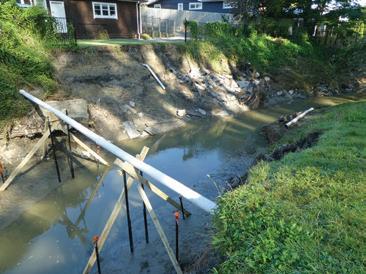
dams, HDC failed to even start drafting EAP’s until after Cyclone Gabrielle.
Resource Consent Breach:
Mr Boshier dismissed the Council’s excuses for failing to obtain a required Dam Safety Review for 2021, deeming the omission ‘unreasonable’.
Legal action:
HDC appears to have ignored warnings from its lawyer in 2006 that… ‘Council by inaction had approved private works in a public drain’ and that, if flooding occurred, ‘Council could potentially be sued for not having done something to prevent it.’
Now, an experienced natural disaster lawyer, Grant Shand, assisted by fellow lawyer, Andrew Ferguson, is putting together a Group Action against the HDC and the Hawke’s Bay Regional Council to get compensation for flood affected residents.

If you would like to be part of this group action, please email your details in confidence to:grant@grantshand.co.nz or andrew@dempseyferguson.co.nz
Should Heads Roll?
We believe that HDC’s Mayor, Chief Executive and General Counsel should resign. The Mayor had known about the chronic neglect and mismanagement for years, but after the cyclone, staff deceived residents and repeatedly denied HDC’s failings.
There has to be accountability.


“WE DON’T JUST GROW PINE TREES”
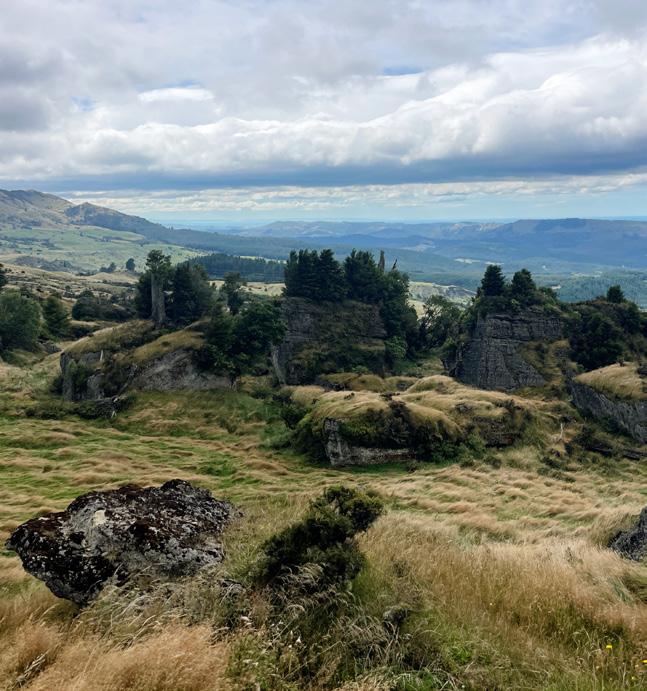
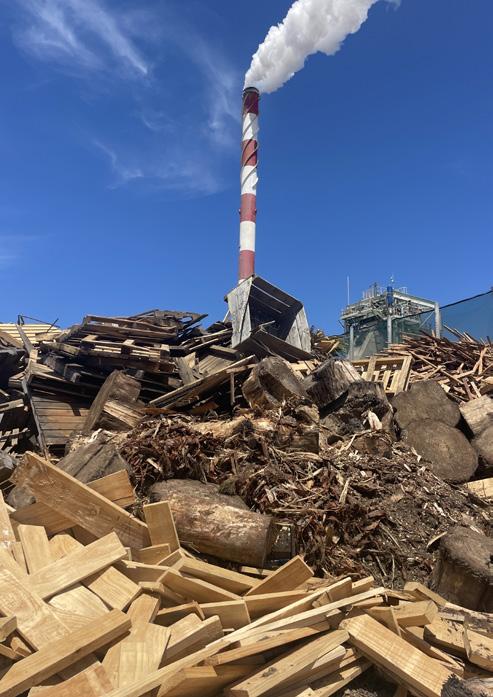
Story by Tess Redgrave
Pan Pac Forest Products’ Sustainability Report will be released mid-May.
The company has a huge impact economically in Hawke’s Bay (see sidebar on p24). And with that comes a major environmental footprint. Their Sustainability Report indicates how the company seeks to meet its stewardship responsibility.
This is Pan Pac’s first sustainability report since 2022 pre-Cyclone Gabrielle. Managing Director Tony Clifford says it captures projects that have been underway for years. “What’s great about this report is we’re condensing all the sustainability initiatives we’re already doing. We’ve been doing sustainability for years.”
Although the report addresses a full range of social, cultural and staff well-being issues, we’ve focused on a number of key environmental projects that captured our attention.
Shredded wood
Trialling the use of shredded wood to pave forestry roads is one innovation.
Damon Wise, Operations Manager with Pan Pac, has been leading this project with support from the Forest Growers Research Fund. It has come out of Cyclone Gabrielle and has been trialling the use of shredded wood taken from unmerchantable logs, slash and other forest waste, to pave roads in Hawke’s Bay forests.
Using a self-propelled–tracked machine, branches and debris are turned into shredded wood, explains Wise. “Roads are then paved 500mm thick with the matt-orientated shredded wood binding together with compaction.”
One forest where the new roading system could have a huge impact is a 650 hectare forest near Frasertown, Wairoa. “It has 26 tributaries exiting the forest joining into two significant waterways,” explains Wise. “Hawkes Bay Regional Council has supported the Resource Consent application to shred all the forest’s biomass and use it on the roads and landings so that nothing post-harvest can enter a waterway and leave the forest.”
And that is the ultimate goal of the shredded road trials: to see if shredded
roads can remove all forest residues from harvesting that create negative downstream impacts, while providing forest owners with economic benefits associated with roading costs.
Pan Pac plans to use shredded wood for short stub roads to skids, on haul tracks, landings and carparks and other areas either too wet or uneconomical to hold traditional materials. If the ground is too steep shredded roads won’t work and if mud is tracked onto the wood road, it can get slippery. “Then you have to put a running coat of metal on top,” says Wise.
Pan Pac knows biomass! For the last 45 years Pan Pac has been collecting sawdust, bark, wood shavings and timber offcuts from its forests to fire two boilers at its Whirinaki-based plant. These boilers in turn provide steam to the kilns and pulpmill for drying lumber and pulp. Currently the boilers burn approximately 220,000 tonnes of biomass per year – enough to bury Napier’s Mclean Park complex in a pile 30 metres high.
Clifford is aware creating more biomass for electricity generation could be part of both its and Hawke’s Bay’s future.
“The price of wholesale electricity just keeps growing and we are considering if we can use more biomass to generate electricity,” says Clifford. “At the moment we can generate up to about 10% of our electricity needs. When we have our boilers running at maximum capacity we have additional heat (steam measuring 7-800 degrees centigrade) that we use through our turbine.”
The turbine runs on steam producing a maximum of 13 megawatts of electrical power at any one time. To note though, the turbine suffered significant damage during Cyclone Gabrielle and is still being repaired to the tune of $6 million, for a re-launch later this year. But Clifford says the turbine rebuild is a part of Pan Pac’s commitment to energy sustainability.
Pan Pac is also working with the HB Forestry Group to see if biomass can be used across the Hawke’s Bay region. “We have a surge capacity and we could distribute biomass out. If, for example, schools got involved and stopped using coal-fired heating systems then they could use biomass. But that would create a big demand in winter and then what would we do with
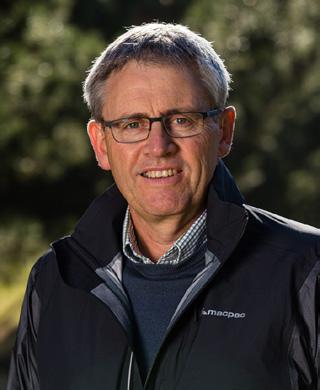
biomass at other times of the year?
“There are complexities with collecting biomass,” he adds. “It has to be clean, no dirt. If you put dirt into a boiler, for example, it will stop working within about six months. You have to be careful storing it too. If you store biomass for too long it starts to self-compost and it can heat up and catch fire.”
There is also the question of transporting biomass. Burning biomass has about the equivalent CO2 emission rate as keeping it on the ground, so the cost of transporting it and the CO2 emissions that will incur, have to be weighed up against using another fuel. The sweet spot for Pan Pac is transporting biomass for about 50 -70 kilometres max. from where it is collected.
Pan Pac is also interested to see if treated timber, used across Hawke’s Bay, could be used as biomass and is hoping to conduct trials with the HB Regional Council soon.
“We’ve been handling and converting biomass for a long time so it’s logical we can help others in the region,” concludes Clifford. “It is definitely an opportunity we are watching closely.”
Another big gain in Pan Pac’s commitment to sustainability was the purchase last year of Rock Station – a 627-hectare property at Te Pohue that contains a 31-hectare block of remnant native forest with a QEII covenant on it.
Environmental Manager Reece O’Leary has worked with local iwi and mana whenua to identify important sites on the property. Deer have been culled from the native forest and possum and pest traps have been set. Pan Pac has also finalised a new policy to double setback limits, which means no planting of pines or forestry operations

within 10 metres of wetlands and waterways (national regulations require five metres).
O’Leary is working on public access to the Te Pohue property so that tramping groups and other interested parties can get up to Te Waka Range and its magnificent views. An area near the top of the range has been identified as a site to grow myosotis peteolata (native forget me knot). One of these plants was identified on a neighbouring property and Marie Taylor of Plant Hawke’s Bay has been growing plants from collected seed which will be planted over winter. Natives sourced from local nurseries will supplement the native bush area.
Rock Station is the second Pan Pac property to have a QEII covenant. The Fisher Block just north of the Whirinaki Mill, now called Pākuratahi Bush, has a 68ha native block within its total area of 298ha. Input from the HBRC, local mana whenua and the QEII National Trust contributes to the management of the site.
O’Leary sees the two QEII covenants as good news in the current political climate questioning farms converted to forestry, and he points out that across all Pan Pac forests from Wairoa to Gwavas there are 5,000 hectares of native forest.
“Most people look at Pan Pac and say you guys grow pines, but we’re a lot more than that.”
Another Pan Pac win for sustainability has been creating a fish pass on Tamingimingi Stream on the Pākuratahi block. After Cyclone Gabrielle, a flow monitoring weir needing repairing, at the same time migratory fish like inanga and bullies needed help navigating up stream. So a project involving NIWA, Australian fish passage services, HBRC, and led by Pan Pac fresh water ecologist Dan Fake,
was launched with a fish pass designed by Australian fish passage services.
“The design both caters for the swimming capabilities of native fish, and ensures resilience to flood events by embedding boulders into the stream bed,” says Fake. He explains an excavator was used to carefully place the boulders into the stream in rows that create “steps” and resting pools for the fish. Smaller fill material was then placed and compacted in the bed to fill in the gaps and further secure the boulders.
“The stream was monitored using electric fishing before the fish pass was installed. The monitoring will be re-done next summer which will allow for spring migration of juvenile fish from the sea.”
initiatives
And if all that wasn’t enough, there is more to Pan Pac’s sustainability programme: Forests are being made more resilient with better water flow management, including building and re-building bridges and culverts. Efforts are going on to protect the threatened Kārearea (native falcon) in Pan Pac forests. The company is also partnering with Essity Australasia providing pulp for its eco- tissue production at Kawerau paper mill in the Bay of Plenty, and is providing timber to Auckland-based company Abodo which is making pest traps for use back on Pan Pac’s QEII covenanted land.
And one project that might not make this year’s report but is special is a new community-based native nursery being established on site at Whirinaki. “It’ll grow 10,000 seedlings a year,” says Environmental Manager Reece O’Leary. “We’re just getting it built and we’ll be producing plants next year, which will all go back into the Esk Valley.”
A big win surely, for Pan Pac, the local community and Hawke’s Bay.
Emissions profile
Pan Pac’s emissions are independently audited by Toitu, most recently just prior to the cyclone. At that point, annual emissions totalled 270,000 tCO2e per year; these were offset by forest sequestering of about 1,200,000 tCO2e per year, so their net carbon position was approximately 930,000 t CO2e of absorption/sequestration per year to the good.
Pan Pac has achieved Bronze status under Toitu’s standards for its environmental management performance.
Says Managing Director Tony Clifford, “We are still actively working towards reducing our site greenhouse gas emissions, but the cyclone has put us back two years in progress. We were in the process of increasing our certification level to Toitu Silver or Gold just prior to the cyclone and will reestablish this aspiration now that we are back to full operations.”
BayBuzz will report future progress.
Direct workers (2020): 833 FTEs – 1.1% of HB’s FTEs
Total employment impact: 3,250 – 4.1% of HB’s FTEs
Total impact on HB GDP: $541 million – 6.3% of HB GDP One-third of Napier Port volume
Total tax revenues generated: $135 million
Total forest area in HB: 36,000 ha.
Annual harvest & replant: About 1,000 ha/yr
Cost of Cyclone Gabrielle: $300 million
Pan Pac Environmental Trust: Grants $100,000 per year to community projects
www.panpac.co.nz/ pan-pac-environmental-trust/


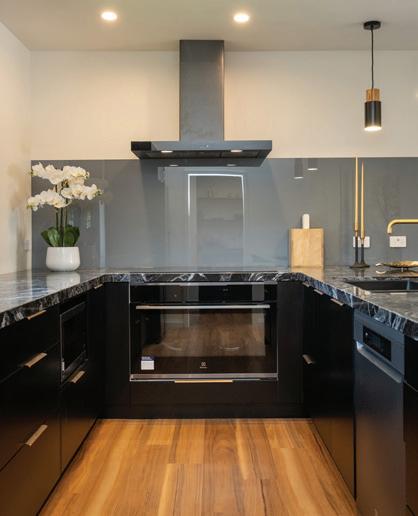

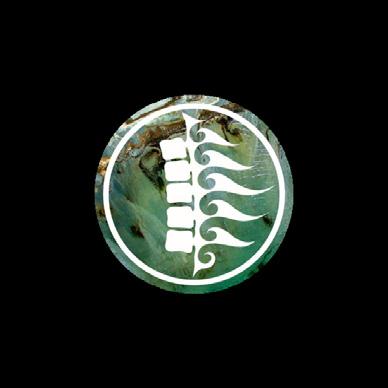

Simon Shattky talks to Scott Lawson about our broken food supply.
There’s a bit going on in Scott’s life when we meet.
His organic blueberry harvest is nearly wrapping up for the season, and he’s just finished recording a podcast for Organics Aotearoa New Zealand of which he’s the spokesperson. He’s squeezed me in before a visit down the line to attend a trade show.
Scott Lawson has 6 hectares of blueberries planted not far from Bridge Pa. ‘We’re certainly not big,’ admits Scott, but the fruit does well here, favouring a low PH soil, high in organic matter. First grown commercially in the Waikato about 25 years ago, blueberries are now grown from Far North to Southland, although this will no doubt change as the climate does.
Scott’s interest in sustainable foods started as a young boy looking for ways to make some pocket money, growing pumpkins in the family’s Twyford orchard. ‘Now we’re importing fresh pumpkin from Asia. And kumara,’ says Scott, pointing out how broken and industrialised our food system has become. “We don’t eat local and we don’t eat seasonally and we don’t eat fresh,’ he adds, telling me that frozen South American blueberries arrive here cheaper than what local growers can supply.
Even food grown here is often shipped to a supermarket distribution centre in Auckland, then distributed all the way back to the supermarket in the Bay. ‘They call that progress,’ says a frustrated Scott dryly.
True Earth Organics grows 15 varieties of the small round deep blue fruit, largely for the domestic market, with
a premium grade and a ‘baking grade’, which is pretty much just cost recovery, says Scott, and sounds much fancier than ‘seconds’.
Certified organic means grown in a biologically active manner, and that means soil, rather than the somewhat less organic sounding ‘growing media’ often based on coconut husk. But it also means managed in a way to increase biological activity. GMO and pesticide-free are givens. There’s even a mantra: healthy soil equals healthy food equals healthy people, says Scott, repeating it again for emphasis.
The organics industry is a billion dollar business in New Zealand, in 2020 we exported $420 million dollars worth, which is not to be sneezed at. “We need to protect and enhance our natural capital. Our soils and our water.” Scott is pretty resolute on that.
The food system is pretty fragile the way Scott sees it. There are no commercially grown capsicums or tomatoes in the Bay anymore. Market gardens in the fruit bowl of New Zealand are closing. Scott estimates we had about 20 at the start of 2000 and thinks there’s about half a dozen today. There’s a whole lot of reasons for the closures, and land use is a biggie. “In the Bay we’ve lost 10,000 acres of prime land in the last 40 years to housing and industrial development,” says Scott, quoting ex-MP Rick Barker.
But if it’s not one thing it’s another …
The Government’s 2023 legislation, the Organic Products and Protection Act, was designed to provide some sort of protection for growers like Scott. “It gives legal protection to the word organic,” he adds. The process took ten years to get the bill passed and it’s yet to be implemented. Hardly what you’d call moving with indecent haste.

Where there is urgency, however, is in passing another piece of legislation – the Gene Technology Bill, which is doing the rounds as we speak. The bill, essentially designed to take the handbrake off the ban on GMO, covers two main areas, the medicinal side – T-cells for cancer treatments and insulin production, and food and the environment.
On the food side, it’s legislation at complete odds with the Organics Protection Act and “it’s so poorly written it isn’t fit for purpose,” says Scott.
Minister Judith Collins is unsurprisingly quite front foot about the bill.
“This is a major milestone in modernising gene technology laws to enable us to improve health outcomes, adapt to climate change, deliver massive economic gains and improve the lives of New Zealanders,” says Collins, who added how proud she was to be driving these changes for the country.
Our history with Genetic Modification in New Zealand is quite visceral.
Following a 2001 Royal Commission, in the infamous 2002 ‘Corngate’ interview, journalist John Campbell asked Prime Minister Helen Clark if she had misled the commission, and covered up a release of genetically modified corn onto ‘our dinner plates over summer.’ A right kerfuffle followed, with the PM calling Campbell “a sanctimonious little creep”.
The Royal Commission meanwhile concluded we should explore genetic technology, but “preserve our opportunities”.
The role ‘Corngate’ played in making genetic engineering politically untouchable is probably one of the reasons MBIE notes in its advice to their boss that, “there may not be social licence
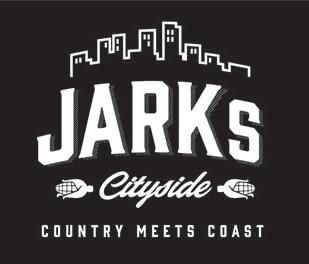
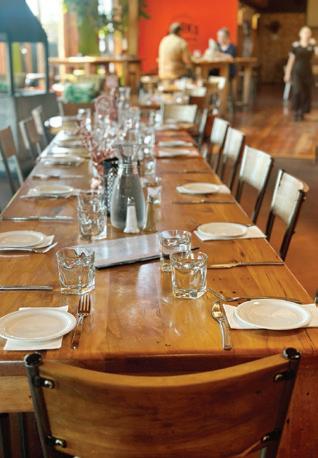

for some of the potential uses” and “generally New Zealanders are more supportive of the use of gene technologies in healthcare and conservation than in food production and farming”.
Scott and Organics Aotearoa New Zealand have commissioned the only economic impact report on the proposed legislation, using the New Zealand Institute of Economic Research, who say: “If market perceptions that New Zealand is GE-free creates a premium of 24 percent over basic world prices, the loss of that perception would be worth $10.6 billion.”
So if that’s what the government is prepared to risk, what are the ‘massive economic gains’ that has made the Minister so proud?
It’s hard to say. MBIE, the government ministry who should have commissioned this sort of research, say they didn’t have time. Their Regulatory Impact Statement – a due diligence report that outlines the costs, benefits, and likely impacts of any proposed law –said: “We are unable to comprehensively quantify these expected benefits as technology development is uncertain.”
The public consultation process on the bill was roundly criticised, even by the Regulatory Impact Statement, as at best minimal, buried over the Christmas/ summer break. “They cynically called for public submissions two weeks before Christmas,” says Scott, making it easier to understand his frustration. He is at a loss to explain the rush.
What MBIE were more certain of was that there would be a cost to organic farmers like Scott if the bill becomes law. The report says: “The expected costs of the proposal are in unquantified costs to organic/non-GMO primary producers. There would also be additional costs for organic and other certified non-GMO supply chains to meet assurance requirements.”
The “massive economic gains” Minister Collins claims for the Gene technology bill remain a mystery.
The only example MBIE gives of how we might benefit from genetically modified food, is non-browning mushrooms that would stay white longer. They’re not great keepers mushrooms, and have a shelf life of only ten days. Again, it was left up to NZIER to uncover the real story.
Like Dolly the sheep, the world’s first cloned mammal, and the dire wolf –recently made de-extinct in a Jurassic Park-like moment – non-browning mushrooms have had their DNA altered. Non-browning mushrooms were
“We need to protect and enhance our natural capital. Our soils and our water.”
Scott Lawson
developed using gene editing technology called CRISPR by Penn State University back in 2015, a feat that got everyone all excited, until they weren’t, and a decade later we still don’t have non-browning mushrooms available in any meaningful commercial way.
The NZEI report makes a good point. The removal of regulation alone doesn’t mean a successful economic outcome. Not every innovation makes it to market.
If there is more risk than there is reward with the legislation, and given New Zealanders don’t seem particularly ready to embrace the “massive economic gains” to be made through the growing of non-browning mushrooms, why not carve off the food modification aspect of the bill entirely?
It’s a strategy that OANZ are looking at, says Scott. If they can’t put the skids under the gene tech bill entirely, Scott believes limiting gene tech use to healthcare applications is certainly an option.
But this too comes with a risk, as all tampering does. There’s no putting stuff back in the bottle. “Humans share 98.5% of our DNA with monkeys,” says Scott, to make the point. “You don’t have to change much for a completely different organism.”
The gene tech bill is definitely something to think seriously about, but it’s also somewhat of a sideshow, according to Scott, overshadowing the fact that we’re not resourcing our food system.
“We’re bad at marketing the importance of good quality food,” says Scott. “We could reduce poor health outcomes by investing in quality food production,” he adds. “We need a food strategy. Start with the basics, what do we need to resource food production. People, training, investment, supply the right seeds.”
I wonder if Scott has thought about mentioning this to the powers that be in Wellington, as it’s the sort of thinking from which “massive economic gains” can be made.
Food for thought indeed.

Body in Motion, a Bay of Plenty and Waikato-based allied health service provider, operates 12 clinics and multiple satellite services in the community, employing over 150 people. Body in Motion Business Support Manager Camille Sanders says the organisation chose to partner with Now Business because they needed efficient business broadband and smarter phone solutions for their clinic and community team.
Flexible system
Body in Motion needed a solution for front line staff to work from multiple clinics. “Most of our admin team works from at least two clinics, so it’s very important that they can easily work from any location, whether that’s in the clinic, from the community or at home,” says Camille.
In-depth reporting
“The Now Reach reporting capability not only lets us make sure our customer service is up to standard. Our weekly reporting for each region also allows us to see how many calls are answered to monitor demand, and to help manage our team’s performance,” says Camille.
Supporting growth
The growing business acquired a number of clinics, rolling out the phone system to a new team.
“It was really easy because we were already familiar with Now’s system and what we wanted – we were all on the same page,” says Camille.
Now Business provided an onsite technician to offer dedicated support during the move.
Efficient and cost effective
Working closely with the Now team has also enabled Body in Motion to ensure the solution is the most efficient and cost effective for their use.
“Initially we created a licence for everyone –including each therapist,” says Camille.
“We noticed the therapists, in the clinics and even in the community, weren’t using their lines.
We really appreciated that we could reduce the number of licences. The flexibility is important, and the cost savings were significant.”
Ready for smarter solutions?
Contact Now today and discover how we can future-proof your business communications.
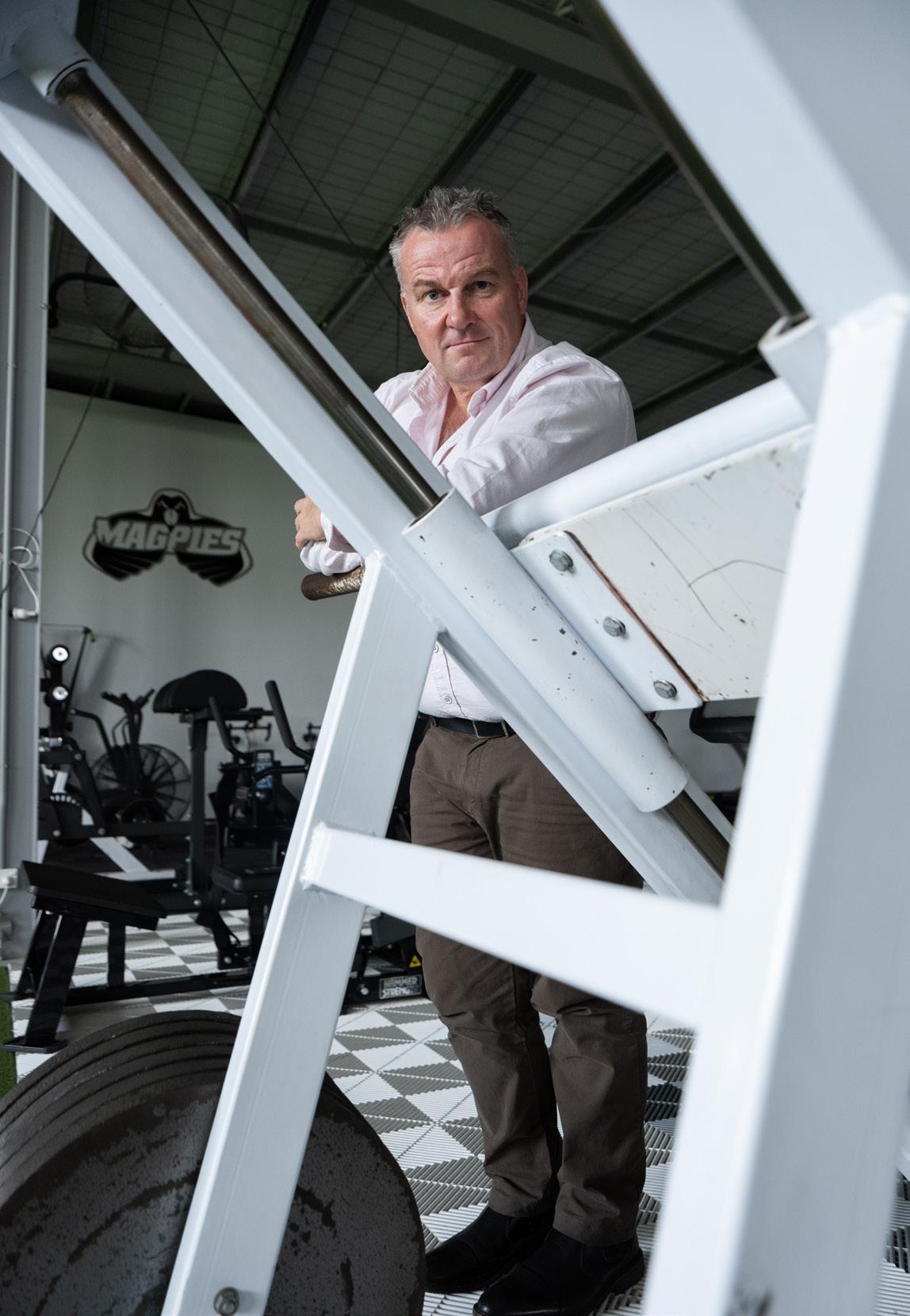
“We’ve got fans of all ages. Our job is to make match day engaging for kids, teens, families and die-hards alike.”
Magpies CEO, Jay Campbell
What it really takes for Hawke’s Bay’s top sports teams to compete on the national stage.

Story by Damon Harvey Photos by Florence Charvin
“Black white, all right! Come on the Bay! Got the team together, ready for the fight, Give it all we’ve got to give, we know we’ll get it right.”
These lyrics from Come on the Bay, written by Hammond Gamble in 2007, were created to unite fans of the Hawks basketball team, the Magpies rugby side, and Napier City Rovers (NCR) football club.
The parochially charged anthem was a hit then—and it still echoes around McLean Park today. But flying the black and white (or NCR’s blue and white) colours of Hawke’s Bay in New Zealand’s top domestic competitions is no cheap exercise.
Just like the lyrics suggest – Give it all we’ve got to give, we know we’ll get it right – sitting behind the passionate fans, community pride and packed stands at Pettigrew Green Arena, McLean Park, and Bluewater Stadium are three franchises hustling hard to keep the wheels turning and the scoreboards ticking.
Whether it’s basketball, rugby or football, the financial realities of fielding a competitive team in a national league are significant.
From player recruitment and game day ops to travel and accommodation, the cost of representing Hawke’s Bay at this level isn’t just a line item – it’s a season-long balancing act.
For the Magpies, a competitive National Provincial Championship (NPC) campaign costs around $1.8 million a season, with $1.2 million of that going to salaries. The squad operates under a $1.1 million salary cap, so building depth takes careful planning.
“It’s a balancing act,” says Magpies CEO Jay Campbell. “We’ve got a loyal commercial base that backs us, but the costs continue to creep.”
Across town, the Hawks run a leaner operation, on paper at least, with a $750,000 annual budget.
“That doesn’t include the huge amount of volunteer graft that goes into delivering each season,” says Hawks chair Sally Crown.
“Until this year, we only had one full-time employee. We’ve only just added a part-time operations role for the 2025 season.”
Then there’s Napier City Rovers, an amateur football club playing in a semi-professional National League. Their full season costs, including
regional and championship phases, sit between $250,000 and $300,000.
“We’ve only got one full-time staff member,” says head coach Bill Robertson. “Everything else runs on passion, volunteers, and the belief that what we’re doing matters to the region.”
So how do they fund it?
For the Magpies, sponsorship from the likes of local businesses such as TotalEnergies NZ and hospitality are king.
“Our commercial revenue is around $2.5 million a year, with $2.25 million of that from sponsors and corporate hospitality,” says Campbell.
Gate ticket sales bring in another $250,000. Broadcasting revenue? Not a direct income stream, however televised games on Sky TV are critical for visibility and sponsorship value. “Broadcast is the foundation for commercial revenue – virtual signage, on-field branding, kit sponsorship. If games weren’t televised, our revenue would take a huge hit,” says Campbell. “It also gives the code visibility, helping it stay relevant for participants and fans.”
NZ Rugby contributes nearly $2 million annually to the region: $450,000 for the Magpies, and a further $1.5 million to

“We host 11 games a season. That’s 160 bed nights for visiting teams alone. Add supporters, hospitality spend, wellness services, tourism and there’s real impact on the local economy.”
Hawks Chair, Sally Crown

support grassroots development.
The Hawks rely heavily on partnerships too. Naming rights sponsor for the 2025 season is locally owned alcohol retailer Big Barrel.
In 2024, 41% of revenue came from sponsorships, 25% from charitable funding, and 15% from ticket sales.
“We’ve just entered Year 2 of our strategic plan,” says Crown. “A new commercial strategy is helping us diversify income, giving us a clearer view of how and when we spend– and
For Napier City Rovers, community support is the backbone. Local business sponsors such as Thirsty Whale, match-day revenue ($5 tickets, free for kids under 14), and charitable funding are crucial.
“There’s no broadcast money. We get a small travel allowance from NZ Football, and we still pay a $12,500 entry fee,” says Robertson. “So we rely on goodwill, grit and making every dollar count.”
To compete, you need talent – local and imported. For all three teams, recruitment is a moving target.
In 2024, the Magpies had 23 players schooled in Hawke’s Bay and another seven who came through local academies or clubs. But few play their regular season rugby in the Bay.
“The pathway is club to NPC to Super Rugby – or overseas competitions like Japan, Europe, and the US,” says Campbell.
“We’ve helped players like Cooper Flanders, Lincoln McClutchie and Ollie Sapsford progress. But the gap between club and NPC rugby is wide, so development takes time.”
The Hawks have leaned heavily into development, especially with the new Rapid League, a short-format curtain-raiser to the NZNBL that gives local talent more exposure. “We’re building a consistent core,” says Crown.
“This season six players have rolled over from last year. We want Bay players to see a pathway to the pros without having to leave home.” Imports still play a key role, particularly for specialist positions.
“They bring skills we can’t always find


“We’ve only got one full-time staff member. Everything else runs on passion, volunteers and the belief that what we’re doing matters to the region.”
Napier City Rovers Head Coach,
Bill Robertson
locally,” says Crown. “But they must fit our culture. That’s non-negotiable.”
City Rovers depend on outside recruitment to stay competitive. NZ Football allows four foreign players per team. Rovers usually max it out.
“Many become long-term locals. Our captain Jim Hoyle has played 200 games since arriving in 2015,” says Robertson. “He’s now a permanent resident.”
The revolving door is real in football as young players often leave for uni. “Some years we’ve had to recruit 12–15 new players. Others, just four or five. But we always aim to retain a strong local core.”
One truth binds all three teams: winning helps everything. The Hawks last lifted the national title in 2006, but have been consistent top-four contenders in recent seasons. The Magpies have proudly held the coveted Ranfurly Shield multiple times, while Napier City Rovers finished fourth in the National League last year.
“You can have the best marketing and game-day experience,” says Campbell, “but if you’re not performing, the crowds don’t show up. Simple.”
Crown agrees. “When the team is winning, all the psychological triggers are firing – community, pride, identity. That turns into ticket sales. The challenge is replicating that feeling even when results don’t go your way.”
Rovers have seen gate numbers rise with results, but Robertson also credits
their family-friendly vibe. “It still feels like club sport. Kids run on the pitch, get autographs and feel part of something. That connection matters.”
Beyond results, fan experience is everything. The Hawks run school programmes, holiday clinics, sponsor activations and giveaways.
“We’re hosting people,” says Crown. “It’s not just sport ... it’s hospitality. Manaakitanga goes a long way.”
The Magpies have a Fans Council that provides regular feedback on the matchday experience. “We’ve got fans of all ages,” says Campbell. “Our job is to make match day engaging for kids, teens, families and die-hards alike.”
NCR embrace their old-school charm: halftime junior games, walkons with the players, and post-match connection. “Our players are amateurs with full-time jobs. But on Sunday, they’re heroes,” says Robertson. “That relatability matters.”
Television coverage remains crucial—for both visibility and value.
“No signage is worth anything if it’s not seen,” says Campbell. For the Hawks, the Sky partnership is a cornerstone. “It’s our cash-flow constant,” says Crown. “It helps our sponsors justify their support. Broadcast grows our fanbase and the league’s value.” It also boosts the local economy.
“We host 11 games a season. That’s 160 bed nights for visiting teams alone,” says Crown. “Add supporters, hospitality spend, wellness services, tourism and there’s real impact.”
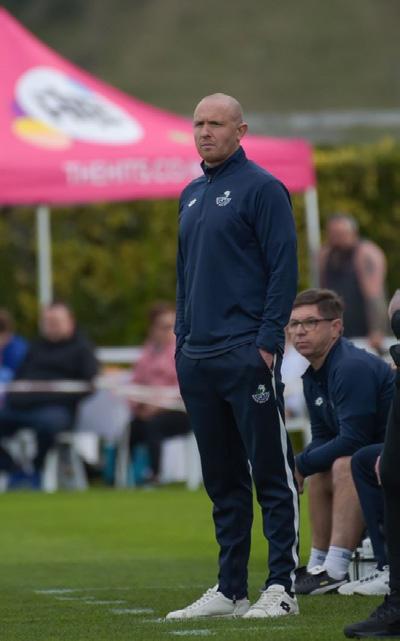
There’s no sugar-coating it: competing at this level is tough. Financial, logistical, and structural challenges are constant. But the payoffs, tangible and intangible, keep these teams pushing forward.
For the Magpies, it’s about fuelling community engagement through high performance. For the Hawks, it’s about growing franchise equity while staying grounded in local identity. For Napier City Rovers, it’s preserving a pathway for footballers in a region where they’re the only game in town.
“We know what we’re up against,” says Robertson. “But we also know why we do it.”
In Hawke’s Bay, sport is more than a scoreboard. It’s a shared story. And flying the flag – however costly – is a responsibility these teams carry with pride.
Black! White! All right! Come on the Bay!
Starting like most kiwi kids playing rugby barefoot on frosty Hawke’s Bay mornings, Damon became a sports editor for the local rag and then a sport promoter for the ASB Tennis Classic, the national rugby championship and the Auckland Blues. He served 15 years on the board of Sport Hawke’s Bay, five years as chair, and continues to be involved in sport governance locally. A third-term Hastings District councillor, in his spare time he’s an action man – surfing, mountain biking, a gym bunny and a newcomer to water polo.
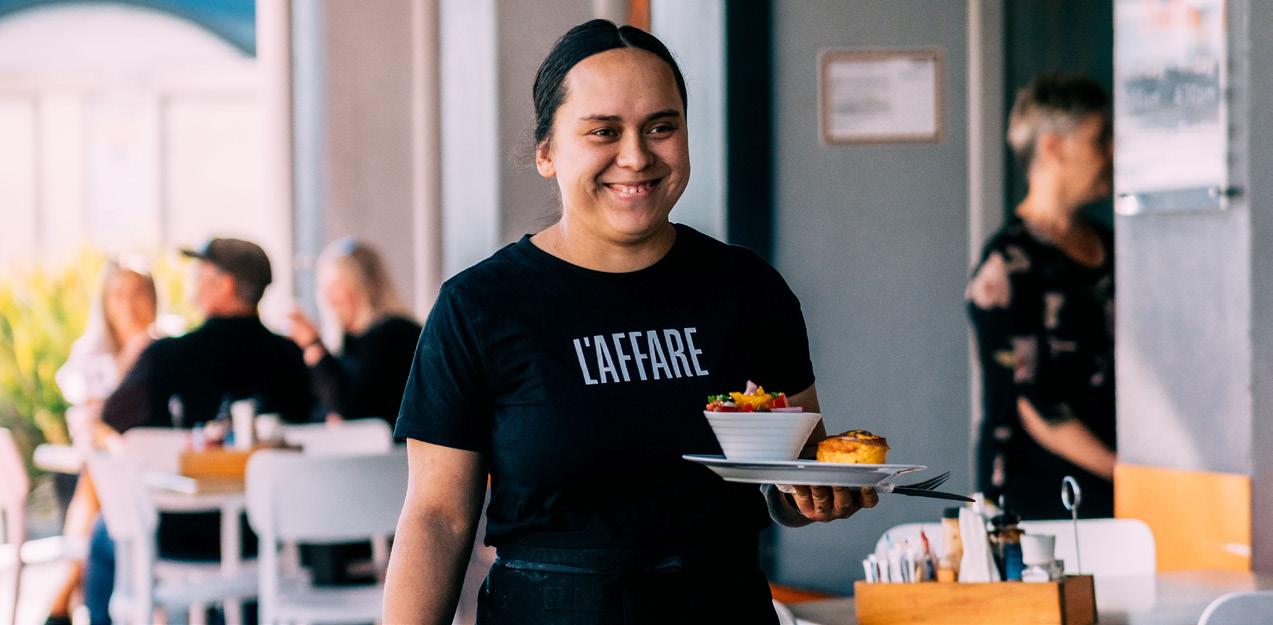

Kaweka Hospital is pleased to sponsor BayBuzz coverage of sport and fitness in Hawke’s Bay.
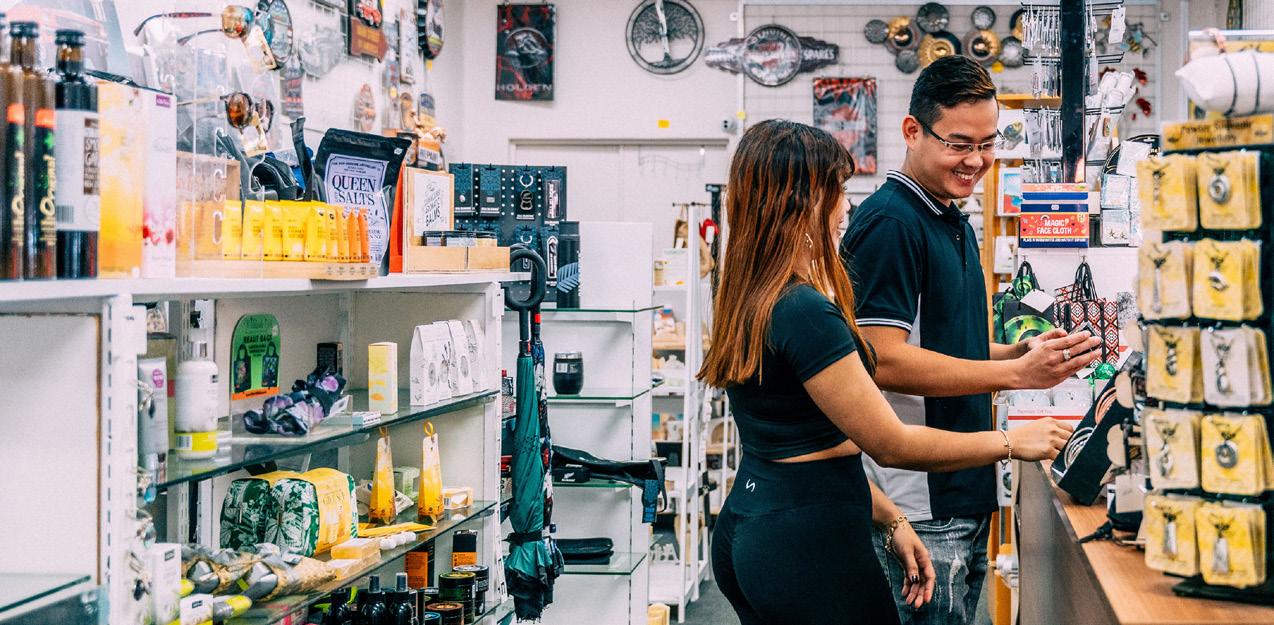





Hospital waiting lists are in the news, with Health Minister Simeon Brown choosing to outsource more elective surgeries to private hospitals in a bid to reduce waiting lists.
How does this play out in Hawke’s Bay’s health sector? Who are the players, and what are they doing? Is outsourcing good, or does it create problems? In this article we hear from private and public hospitals about how they work together, and a health systems expert about the increasing role private hospitals are playing.
The OG – Royston Hospital Royston is a name that’s been synonymous with private healthcare in Hawke’s Bay for more than 100 years. Established in 1921, the hospital has gone through a number of ownership structures over the years, and today is owned by Evolution Healthcare, an Australian-owned leading provider of healthcare services in New Zealand.
These days, Royston Hospital positions itself as the number one provider of private healthcare services in Hawke’s Bay with 180 staff and seven operating theatres serving more than 5,000 patients a year across day surgery and in-patient surgery supported by a 33-bed ward.
Then there’s the patients who come to the Royston campus for private consultations with surgeons, or x-ray appointments with Canopy Imaging or physiotherapy appointments with Focus Health Physiotherapists, all of whom work from the Royston site. Royston’s surgical specialties are regional anaesthesia, bariatric, gastroenterology and endoscopy, general surgery, gynaecology, ophthalmology, maxillofacial, orthopaedics, plastic and reconstructive, urology, and vascular.
Royston’s business comes from four main sources: clients with health insurance (of which Southern Cross is the largest provider), individuals self-paying, and referrals from the ACC system (about 15%). Outsourced patients from Health NZ represent less than 20% of Royston’s business, but this can fluctuate from year to year, with the volume driven by Health NZ.
Denise Primrose, General Manager Royston Hospital, says that Royston
has been receiving outsourced patients from the DHB since 2003.
“It has been a long standing relationship assisting with capacity issues at the DHB. There has previously been an MOU (memorandum of understanding) in place with HBDHB, now contract based agreements are negotiated with Health NZ (HNZ).
“HNZ outsourcing of patients for their procedures may be either under a ‘wet theatre’ arrangement, where the surgeon comes from the HNZ payroll to work in Royston’s operating theatres, with Royston providing the facilities, theatre staff, ward staff, and wraparound services. Or, more commonly, where HNZ patients are outsourced to Royston and we provide the same wraparound services, but the specialists work with us while in their private capacity, outside of their HNZ commitments.
“Over those years, thousands of people have come to Royston (from the DHB) as patients,” says Primrose.
In the last three years Royston invested $22 million to increase the number of operating theatres and expand postanaesthetic care, and a further $11 million to create a brand new orthopaedic day facility as a joint venture.
Evolution Healthcare and leading local orthopaedic surgeons came together to establish Royston Day Surgery in 2022. This brand new two-operating theatre facility, with 28 staff, performed 1200 operations this past year with growth expectations of 10% next year.
The bulk of Royston Day Surgery’s clients are funded by ACC says Lesley Henderson, General Manager Royston Day Surgery, with Health NZ referrals only 3%.
“Our demographics are completely different to Royston Hospital. Our biggest group of patients are working age, who are fit and healthy, that have shoulder or knee injuries that require reconstruction.”
By creating the new orthopaedic day facility and building two new operating theatres at its main campus, Royston Hospital has been able to increase the number of in-patient procedures that require a hospital stay.

“The majority of work that Kaweka does is for the public sector. It’s just in the private environment, which of course gives the patient a nice experience.”
Colin Hutchison
Denise Primrose says that Royston Hospital can grow even further, by broadening service offerings, providing additional operating capacity for surgeons constrained by the public system, and expanding inpatient bed capacity as demand is evidenced.
“We have the capacity to do at least 1,500 more surgeries. There are opportunities that we need to continually look for. For example, in spinal surgery, where patients have been travelling out of region for their operations.”
With Health NZ hiring more spinal surgeons locally, Royston invested in a spinal navigation system to support these surgeons, creating capacity to increase the number of operations they can perform, so that patients don’t have to travel.
“By Royston investing in some of the equipment needed for spinal surgery, we can then offer it, not just for Health NZ patients, but for the broader community. Up until now that has been a constraint for the community,” says Primrose.
Robotics is another area of investment for Royston, made viable by the number of hip and knee operations performed. The technology, worth in excess of $1 million, helps surgeons perform joint replacement procedures with greater precision and accuracy, explains Primrose.
“The team has really embraced the technology, and it’s going really well. We’ve also introduced a new Capsule Endoscopy service to private patients where the patient swallows a small capsule and the camera inside it takes images of the small intestine to help with diagnosing gastrointestinal conditions.
“Our demographics are completely different to Royston Hospital. Our biggest group of patients are those of working age, who are fit and healthy, that have shoulder or knee injuries that require reconstruction.”
Lesley Henderson
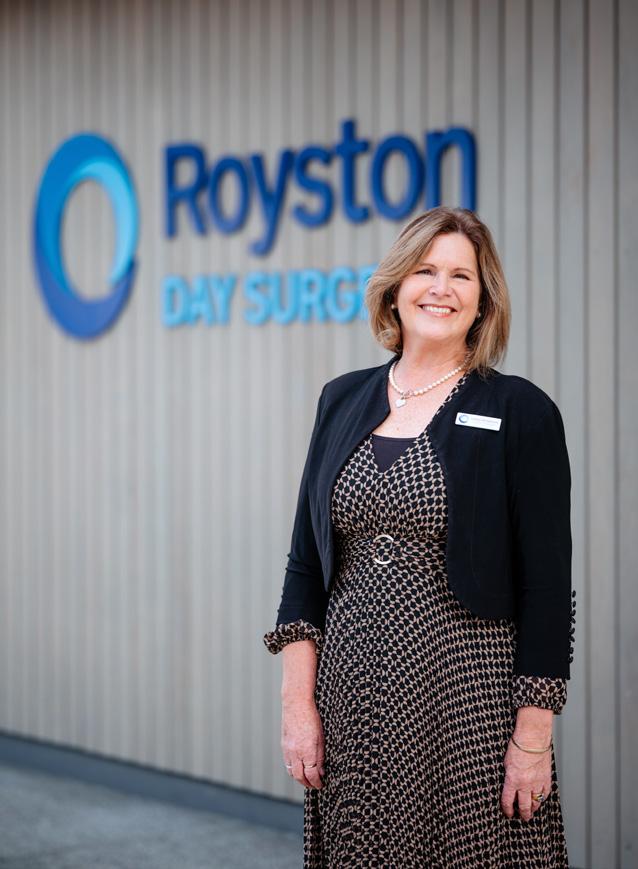
“These are the opportunities that we look to expand.”
New kid on the block – Kaweka Health Kaweka Health is the new entry into private healthcare in Hawke’s Bay with four operating theatres, 80 nurses, 28 surgeons and 31 beds. Funded by local surgeons, other local investors, and supplemented by bank lending, Kaweka Hospital is a $120 million, 75 year health resource for the community, says Colin Hutchison, CEO Kaweka Hospital.
“The banks have supported our project because they see it as a safe place for their money. If you look at healthcare in Hawke’s Bay in comparison to larger regions like Auckland and Christchurch, we are horribly under-invested.
“Ultimately to be able to borrow, whether it’s from a bank or a high net worth individual you’ve got to show them the business case.”
Kaweka’s second stage building is nearly finished, which Hutchison
says provides the infrastructure for more operations, and allows for more complicated cases that require longer in-hospital care.
“It allows us more flexibility of what we can accommodate.”
Hawke’s Bay’s growing, aging and affluent population makes it an attractive prospect for private healthcare providers, and the region is an attractive proposition for doctors in the public system, who then may also work in the region’s private hospitals.
“Hawke’s Bay and Palmerston North are actually really nice regions, because they’re big enough to have sustainability and big enough workforces, but they’re not the big smoke, where you get complicated personalities and the complexities of running departments. That’s why regional New Zealand is very attractive for lots of specialties.”
Hutchison says that Kaweka will be operating on people to the tune of 4-5,000 a year, as well as providing wider care such as scans and hospital visits to another 10,000.
Kaweka’s surgical specialties are cardiology, ENT (ear, nose and throat), epidural steroid, general surgery and endoscopy, gynaecology, ophthalmology, orthopaedic and urology.
Stephen Toynton, Board Chair and Director of Surgery Kaweka Health, says lack of facilities and poor infrastructure are major obstructions to the delivery of public healthcare in Hawke’s Bay.
“Kaweka Hospital was built to increase surgical provision for both the private and public sectors. This has been a successful strategy. Since opening, two and a half years ago, 8,395 patients have received their surgery at Kaweka, 46% of whom were public patients.
“Without the Kaweka surgical facility many of these would have had their operation seriously delayed, and some might have never received it. The new facilities, up-to-date surgical equipment, and a friendly and efficient team have also been instrumental in improving recruitment of new surgeons and nurses to the area,” says Toynton.
Unlike Royston, Kaweka has an
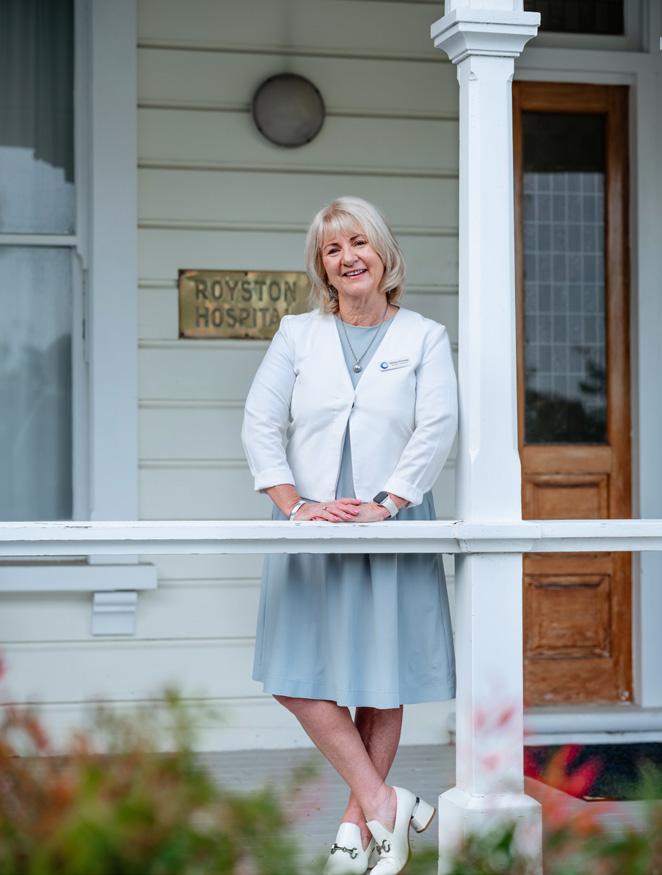
“Over those years, thousands of people have come to Royston (from the DHB) as patients.”
Denise Primrose
intensive care unit, which means it can take on more complicated cases that require longer stays in hospital.
“It allows us to operate on people who have more health complaints,” says Hutchinson. “One of the main reasons that the private sector don’t operate on complicated patients is that they might need breathing or kidney support afterwards.
“Historically private hospitals did the really easy stuff, and then they did a bit more, and a bit more, and now Te Whatu Ora (Health NZ) is basically
looking for the private sector to sup port them. And if you look at some of the Auckland and Hamilton (private) hospitals, they’ve got intensive care units that are just full the whole time.
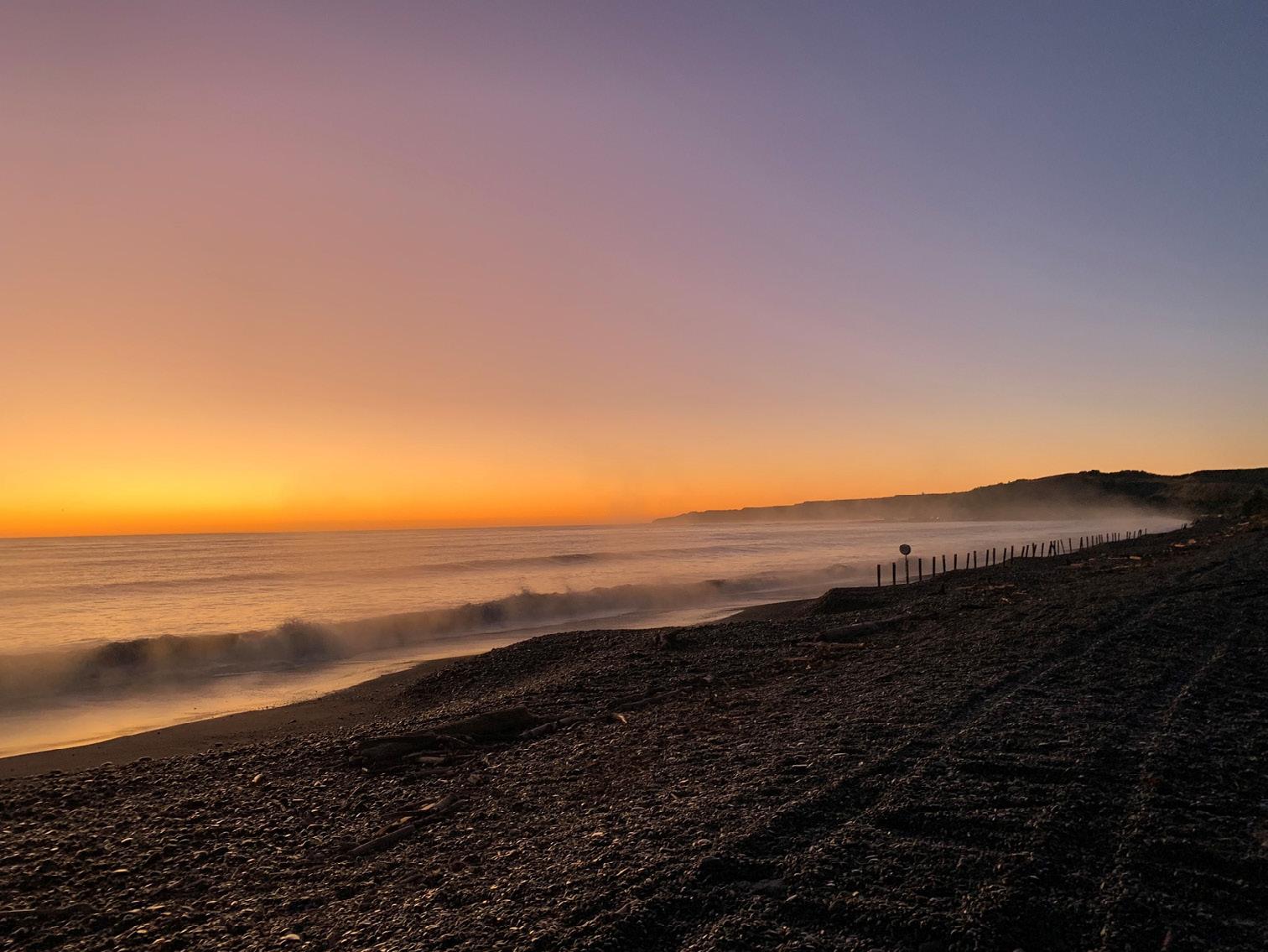
“The majority of work that Kaweka does is for the public sector. It’s just in the private environment, which of course gives the patient a nice experience.”
Hutchison says that public and private hospitals fulfil very different roles, that will become more different for the foreseeable future.
“At the moment, over the last 10 years, they’ve really split away; public hospitals are about acute emergencies and mental health, and private hospitals have become lean machines that deliver elective surgical care.
“The private sector is going to be a wonderful support for public health care for the next generation. But that doesn’t mean you stop investing in public healthcare. The complicated stuff will get done in the public hospital, that’s why you can’t stop investing in it,” says Hutchison.





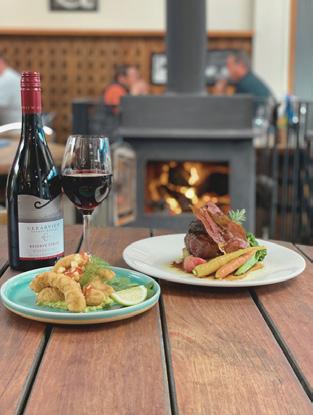





Onsite operations - Public Hospital
Note: This table excludes endoscopy and cardiology procedures as they are classified as procedures, not operations
The mother ship –Hawke’s Bay Hospital
Access to planned care treatment as early as possible is important for the health of New Zealanders, says David Warrington, Hawke’s Bay Group Director Operations, Health New Zealand.
He says that Health NZ has started additional outsourcing to increase the number of planned care treatments across the country by the end of June.
“Hawke’s Bay Hospital has eight operating theatres that deliver a mix of both elective (planned) and
acute procedures. The eighth theatre came online in May 2024 as part of the Surgical Services Expansion Project, and was commissioned to both increase the number of public surgical procedures the hospital undertakes each year and provide more capacity for acute demand.”
The outsourcing of elective surgeries in Hawke’s Bay has been common practice for a number of years. Most outsourced, publicly funded surgery takes place at either Royston Hospital or Kaweka Hospital in Hawke’s Bay.
“Kaweka Hospital was built to increase surgical provision for both the private and public sectors. This has been a successful strategy.”
Stephen Toynton
The table opposite illustrates the mix of onsite and outsourced operations in Hawke’s Bay Hospital since 2020 and reflects the growth in private hospital capacity. Onsite operations are performed at the public hospital, and outsourced operations include when the public hospital uses a private provider theatre with the public hospital’s own staff (surgeon and sometimes, anaesthetist, known as a wet theatre).
Factors such as the length of the wait list, complexity of cases, budget and performance against health targets assist in determining how many elective surgeries will be outsourced each year, says Warrington.
“Outsourcing elective surgeries is key to ensuring faster access to treatment for Hawke’s Bay patients, which is one of the Government’s five health targets. As a result of this approach, Hawke’s Bay elective theatre utilisation is one of the best in the country – sitting at about 90%.”
A lot of surgeons work across both public and private hospitals. Employment contracts articulate the responsibilities of staff employed by Health NZ and the hours they are employed to work, says Warrington.
“We do not keep data on the number of staff who also choose to work in the private sector.”
“The Health Workforce Plan takes a national approach to workforce planning across the whole health system, not just those employed by Health NZ, and we are working towards growing our workforce to ensure that public hospitals, general practice, allied health, community NGOs, private hospitals, aged residential care facilities and other healthcare providers all have the staff they need.”
How public and private fit together There has always been a private component in the New Zealand health system, says health system expert Professor

“The constant claim that’s made is boosting the private sector reduces demand on the public sector. But there’s no evidence to suggest that’s the case at all.”
Robin Gauld
Robin Gauld, Executive Dean, Bond Business School.
“It all came about from the passage of the Social Security Act of 1938, passed by the first Labour government, which also passed legislation to set up state housing, state pensions, and universal access to education. There was also meant to have been a national health service.
“New Zealand would have had the first English-style NHS, ten years before England. The whole idea was that everyone would work for the public health system, and the goals were visionary. Primary care, hospitals and other services all working for the same system, working together, with a preventative rather than curative focus within the system.”
Gauld explains that the British Medical Association of New Zealand put up a fight against the legislation once passed, complaining of the state getting in the way of doctor-patient relations. A compromise was reached, where doctors could continue to charge patients, and the government would provide an amount of money per patient. That model continues today with capitation funding, which is funding per person enrolled in GP practice.
“That’s how primary care was set up, with funding from the government, and the freedom to build patients. The agreement was that doctors working in hospitals would be on a salary, but they would be free to have a private practice.
Nurses, and so forth, would all work for hospitals on a salary. That’s what we have today, and it all comes from this compromise.
“It’s an incredible piece of history, and it’s been completely locked up ever since.”
Gauld says that over the years, private hospitals have served an important role within the New Zealand health system, performing elective services.
“This is unusual globally. Normally a private hospital would be a full blown hospital that does intensive care and emergency care and so forth. But in New Zealand, private hospitals don’t do the tough stuff. They do the easy stuff, which is procedures: hips and knees, cataracts, dermatology and so on. It’s all day-to-day simple stuff, and relatively low risk in terms of what could be ongoing demand on the system overall, which is what the public sector picks up.”
The result of this interplay between public and private healthcare providers, is a two-tiered system, says Gauld.
“If you’ve got insurance or a reasonable amount of cash in your pocket, or if you can beg, steal or borrow, then the private system is for you. Otherwise you’re going to languish and wait in the public sector.
“The public sector does a great job for people who have urgent requirements. If you’ve got cancer, it’s probably more worrying.
“The constant claim that’s made is boosting the private sector reduces demand on the public sector. But there’s no evidence to suggest that’s the case at all. In fact, it’s probably undermining the public sector ultimately, because in many cases it’s the same doctors working in both systems, and more private work by those individuals means they do less public work.”
Surgeons can work under contract to the public hospital, a private facility, or both. Hopefully someone monitors their overall workload to ensure patient safety!
“Unless you have a major boost in the overall workforce alongside the boost to private hospital capacity, then basically it’s a zero sum game. You’re taking capacity out of the public sector to boost up the private sector. That’s a fundamental issue.”
The public system has capacity constraints. Operating theatres and beds are limited, which ultimately restricts the number of procedures that can be performed.
Any specialist you talk to, would say
that they’re a lot more productive privately, says Gauld
“Because they can’t get operating theatre time in the public sector. They are frustrated. Surgeons want to get on with surgery, so they are (almost) being driven into the private sector because they want to keep up their practice. But at the same time, they want to work in the public sector, because that’s where they do their educational and experience development.”
Gauld says, critically, that contracting out to private hospitals undermines the public sector through shifting capacity to the private sector. But at the same time, it frees the public sector up to focus on the more complicated cases. To many, this is an appropriate trade-off. In Hawke’s Bay there are now thirteen private operating theatres to the public hospital’s eight ... a major increase in capacity to care for patients.
But Gauld is concerned about equal access: “The Health Minister has said that the state is still the guarantor of the health system, which is important. But I think if that’s the case, they need to take the conversation one step further and start asking about the funding model itself.” He advocates national health insurance, which would operate like ACC.
“Equity is what’s really important about national health insurance. Those parts of the world that have this model are delivering on goals of equity. It means regardless of who you are or where you live, or your income or socioeconomic status, you’re covered by the insurance fund, and so it’s equitable.”Multiple challenges facing the public health system, including professional frustration with the work environment, and increasing public concern about accessing services is driving private hospitals’ success and growth.
Performing 67% of all elective surgeries in New Zealand, which includes more than 90% of ACC’s elective surgeries, they are an integral part of our health system, ensuring that people get timely care.
But, if doctors are performing more procedures and operations in private hospitals, without growth in the surgical workforce, it’s likely coming at the cost of fewer public operations, which is where the complexity and the really sick people are.
Greater support from the private sector helps in the short term, but will it be good for New Zealand’s public health sector in the long run? That’s a difficult diagnosis to make.
Havelock North boasts an eclectic and enticing mix of boutique stores and providores. From high-end fashion to tasteful homewares and design, the village offers an intimate and unique shopping experience.
Shop local for your fashion needs.


















BayBiz
Tim Nowell-Usticke
“The only wine that Joe Public has ever heard of outside New Zealand is Marlborough sauvignon blanc.”
These words fall harshly on Hawke’s Bay ears!
The world has fallen in love with the unmistakeable tangy, crisp flavours that a glass of savvy brings. But this isn’t especially helpful to Hawke’s Bay wine makers, because our sauvignon doesn’t have the necessary ‘tang’. What can we do about that?
New Zealand has a history of making distinctive and world-class wines, and is internationally respected for its white wines. In most countries that we export to, NZ is the most expensive or second most expensive import per litre. With a new distinctive product, we would be pushing on the already-open door of premium white wines from NZ.
The success of Sauv Blanc can be leveraged in wine-drinkers minds to a sparkling wine that would sell in the same market bracket as Prosecco and Cava. Therefore a new sparkling wine would launch in the field that we are already playing in. [Champagne is a different proposition altogether, belonging in a super-premium category of its own.]
Technically, our wines deliver on NZ’s existing strong reputation for fresh, pure, crisp wines. We are well positioned to grow the right kind of grapes for this. They are already in the ground. Our winemakers are already making great bubbles here in the Bay, but the problem is that all the names for sparkling are a tangled mouthful of euro-names (Methode champenoise, charmat, tirage, petillant, sekt, carbonated etc etc), with the success stories in the sector being Champagne, Cava and Prosecco.
A bunch of little guys with mouth-wrenchingly complicated branding on their bubbles like ‘methode champenoise’ isn’t going to cut it, especially when it is trying to taste like French champagne. We need a point of difference.
Here’s my idea and how it can work: Sparkling wine is the kind of wine that delivers a fun, fresh, and bright wine that younger drinkers want, and that older drinkers have come to expect from the sauvignon that the world knows us for.
I believe that people are turning away from wine because we are stuck in the same groove without innovation. In fact the most recent innovation was 20 years ago when NZ spearheaded the move to quality wine sealed with a screwcap. And then 20 years before that when we unleashed Sauvignon Blanc on the world. What if a group of innovators was to agree on a style of something new and exciting? And our wineries make this new sparkling wine to broaden their range, and help us create an industry-wide recognisable brand that focuses on Hawke’s Bay. Anyone got Kim Thorp’s number?
Then vest ownership of this uberbrand and its IP in a collective body, possibly HB Winegrowers, for our collective benefit. Our winemakers, being individuals, then produce their own slightly different version, but pointing in a collaborative direction. In the same way that Moët is different from Veuve Clicquot.
Why stop with a brand? What about a proprietary coloured bottle that gives it marketing distinctiveness alongside the other coloured, bright fresh brands of alcohol drinks that the young are drinking now?
A group of Hawke’s Bay’s pioneering sparkling winemakers have recently met to consider this concept and push forward. We agree that
Sparkling wine is the kind of wine that delivers a fun, fresh, and bright wine that younger drinkers want, and that older drinkers have come to expect from the sauvignon that the world knows us for.
we’ve got what it takes – the vineyards, the skills, and the let’s-get-intothis attitude. As Rod McDonald said, “If not us, then who?”
The next move would be for a few brave winery owners to take the first step of making their first vintage –and launch a statement to the world of what we are capable of here in Hawke’s Bay.
First we’d like to hear from you wine-loving BayBuzz readers. Have you tried any of HB’s sparkling wines yet? To give yourself a taste of this intriguing opportunity, try any of the HB bubbles that Yvonne Lorkin recommended in BayBuzz Issue 72, Sep/Oct 2023
You are our home-grown focus group after all. Do you see a future in a branded sparkling style that shouts ‘Hawke’s Bay’ to the world? And what would you call it?
Tim founded WineWorks in 1995, born from a desire to establish a food-processing plant in regional New Zealand that added value to primary production. Thirty years later, WineWorks is New Zealand’s leading contract bottler of any beverage or liquid. He remains a director and a majority shareholder in the company.
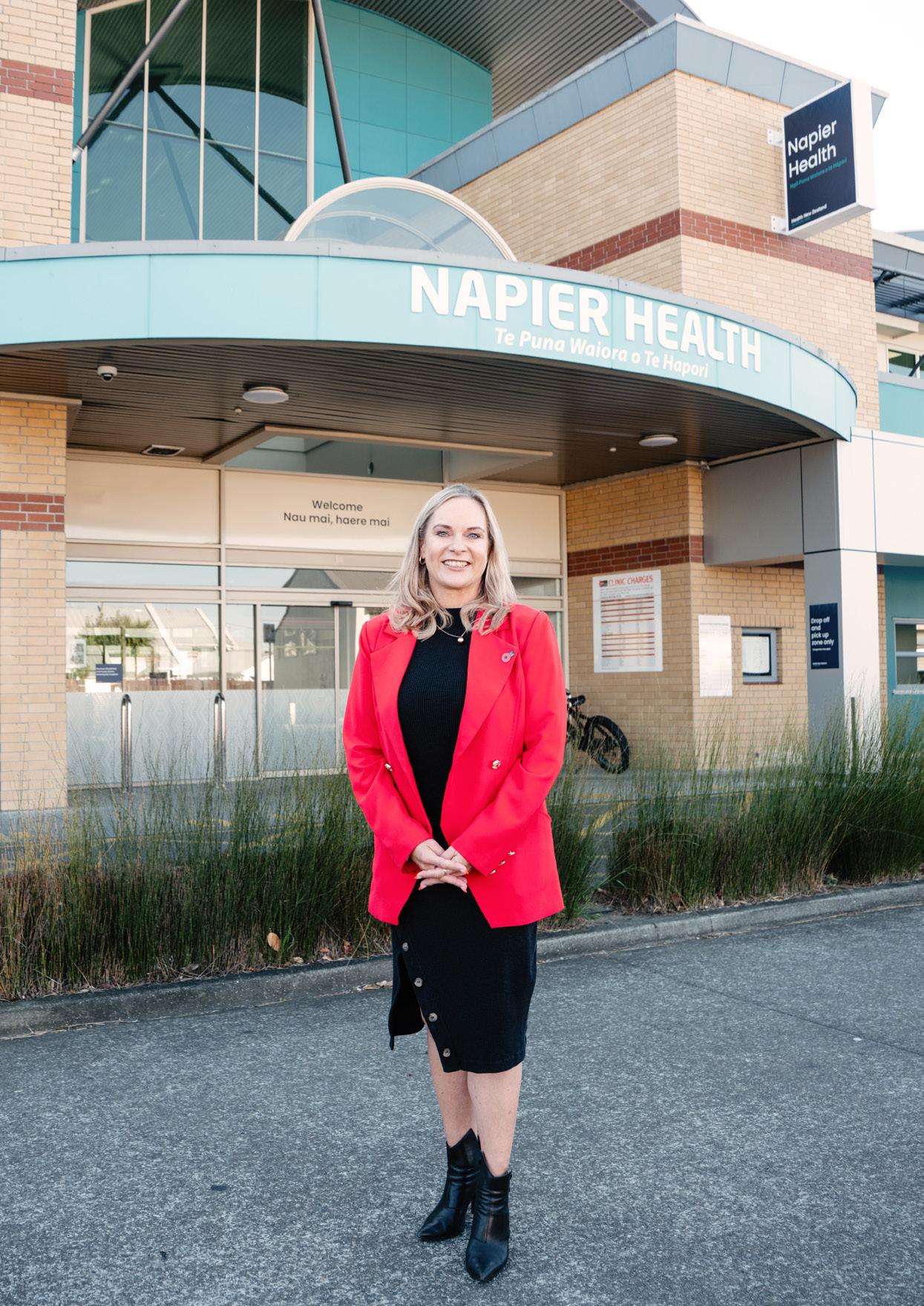
Mayor Kirsten Wise
One in every three people in Hawke’s Bay lives in Napier. We may be geographically small but we are the centre of the region, with the Port and the Airport, major industry and local government. We are a significant visitor destination and home to 67,000 people.
But our health care provision is poorly lacking and any promises coming from central government to remedy the situation are thin at best.
The way we care for our most in need is a measure of the overall wellbeing of a community. This matters more when we have experienced first-hand what it is to be cut off from lifelines. Individuals and organisations speak often of resilience, but for us we have recent lived experience of what that actually means. Beyond strategies and hypotheses, here in Napier we know the practical, factual importance of resilience.
That means having the services and resources we need locally to look after ourselves.
Decades ago, when the Napier hospital closed, promises were made by the government of the time to always have an appropriate healthcare service for the people of Napier. Commitments were made about the level of health care services we would have here in Napier. Those assurances have disappeared. When the promise was made the population was 55,000, and even then the bare minimum was provided. Now, with a population vastly increased, the healthcare provision is reduced even further.
Of all the many things local government is tasked with, healthcare is beyond our remit, but we do have a role
“The way we care for our most in need is a measure of the overall wellbeing of a community.“
to advocate and lobby for what our community needs. And it falls to us to ensure we are resilient against whatever comes our way, whether pandemic, natural disaster or systems failure.
We are the elected representatives of our community and so we speak on their behalf. I have heard loud and clear that ensuring Napier has adequate health care is a priority. We want a commitment to increase health services to the level originally promised.
The more I listen and look into this issue the more I see ‘adequate’ means having an urgent care doctor onsite, it means having an overnight service, it means having community services, and specialist and outpatient clinics. It means having a service that is accessible. It’s too easy to bat the conversation away by saying how close the hospital in Hastings is. But that comes from a place of privilege, assuming everyone has a car, time, resources, assuming there’s no rush, assuming there’s no emergency.
What we are asking for Napier isn’t ‘moon money’. We are realistic about things like maternity, we know there won’t be a birthing annex back in Napier. We know over-night stays are off the table.
We do want the healthcare solution in Napier at least back to what it was before the health centre was stripped out further.
Many have suggested a hub-andspoke model would work well here. We
do benefit from having a major hospital one city over. But the links between what the community needs and that single centralised offering need to be carefully considered. Community voice – patient voice – needs to be central to decision making. Listening only when voices are riled up and protesting is not really hearing what people are saying. I am contacted frequently by people who despair over what we are left with in the way of core services in Napier. I hear from patients, but I hear from health professionals too. As their representative I want to amplify their views, and do whatever I can to make sure they are heard by decision makers.
I am not a sole voice in all of this. There are many community leaders who share my concerns. They too are ready for action and I am driving hard to pull leaders together around one table, as a working group, to lobby the government on behalf of all 67,000 people based here.
The one positive outcome of central government’s move to minimise health services is that it has solidified our opposition to that decision. It has ignited action. Many are now stepping outside their usual responsibilities to fight for the good of our whole community on this issue. Healthcare is a national issue.
On a local level, there are many here who have been fighting on this front since the closure of Napier Hospital was first announced thirty years ago. Over the years other priorities have overshadowed this battle, but now we all need to come together in a unified voice because we are worth more, our people deserve more, we know what it is to be cut off even from our closest neighbourhoods.
Before that happens again, we must ensure we are resilient, and we can withstand whatever comes our way. That starts with speaking up to make sure we have what we need.
Dominic Salmon, 3R


Napier City and Hastings District councils are set to unveil their latest plan for tackling and reducing waste while future proofing the region, and it’s impressive.
Dealing with the waste our communities produce is a core service funded by the rates we pay, so it’s important residents understand and support the goals and activities designed to reduce the need for waste disposal.
At the heart of the Te Mahere Whakahaere me te Whakaiti Para Joint Waste Management and Minimisation Plan 2025-2031 is a progressive, forward-thinking approach to reducing our waste.
Public consultation concluded 11 May, with hearings scheduled for 30 May.
It sets out an ambitious roadmap for reducing by 10% how much waste goes into the system, and by 30% the amount of waste which needs to be disposed of. It also aims to decrease emissions from waste by 30%, down to 22.1 tonnes.
The waste councils collect that can’t be recycled ends up at Ōmarunui Landfill. Overseen by a committee made up of representatives of the two councils and mana whenua Ngāti
Pārau, it’s a significant regional asset. Reducing how much waste is sent to it will extend its lifespan. Landfills have a significant cost to ratepayers – not to mention the environmental cost – so it’s in everyone’s interest to use them as little as possible so they last longer.
The plan puts the circular economy at its core, with no less than 32 mentions and an explainer page.
Circular economy thinking is a break from the current unsustainable linear economy of extracting resources, making things, and then disposing of them. It’s widely acknowledged as the best way to reduce waste and emissions while being environmentally and economically sustainable.
The plan acknowledges the impact of consumerism and a linear economy, which emphasise resource use and then disposal, while encouraging the move to a circular approach which instead emphasises regeneration.
In a circular economy resources are kept in use for as long as possible, so their maximum value can be extracted before being fed back into the system. The result is far less waste and emissions from far more efficient resource use.
Opportunity for commercial waste
The plan has a focus on tackling commercial, and compostable waste. Not surprisingly, these two are big waste streams in Hawke’s Bay, when you consider the size of primary industry and how much food manufacturing there is in the region.
Data for the Ōmarunui Landfill, which accepts most of its waste from commercial and industrial activities, shows that 25% is potentially compostable organic material, and 14% is potentially recyclable (paper, plastic, metal, glass). Combined, this is a huge amount of waste which could not only be kept out of landfill, but have ongoing value.
There’s no shortage of demand for compost on the Heretaunga plains and Hawk Packaging is a paper recycler located in the Hastings district.
There’s also building waste to consider. Some 11% of waste to Ōmarunui Landfill is classed as ‘rubble’ – building waste, which could potentially find another use. The plan aims to work with the construction and demolition sector to find more opportunities to divert waste to other uses.
Some of this work is already underway. There is a building material recycling area at the Henderson Road Transfer Station in Hastings, which opened in November last year.
Flat (window) glass recycling is also now in place at Redclyffe Transfer Station.
Consultation & partnerships
We at 3R Group know well that collaboration is vital to making waste reduction, and sustainability in general, successful.
It’s commendable then that the Hastings and Napier councils have put so much emphasis on engaging with the wider community, including mana whenua and te ao Māori. As the plan notes, traditional Māori thinking and practices emphasise living in synchronicity with the natural world, which means a mindset of sustainability and regeneration are an intrinsic part of existing as Māori.
Viewing waste reduction through the lens of the Māori worldview highlights just how negatively landfills impact on Papatūānuku, the earth we all live on.
Kerbside waste and recycling
This is the way most of us interact with the waste and resource recovery system – a system which here in HB has been using industry best practice for some time already.
In early 2024 central government standardised kerbside recycling around the country. Napier and Hastings were already using the system of collecting recycling separately, as well as a 120 litre wheelie bin system for general waste.
What is being put in the wheelie bins is an area of concern and a way everyone can help do their part. Data
shows just 42% of what goes into general waste wheelie bins is actually waste – the rest is compostable, like food scraps and green waste (42%), and recyclable (12%).
The plan aims to identify opportunities for reducing this waste, but residents simply sorting their recycling well and avoiding putting food and green waste in the general waste bin would go a long way.
Household food scraps are a small part of the organics making their way to landfill, and the plan has no initiative for food scrap collection. But a home compost bin or worm farm is something many households could easily set up to cut down on the waste they put at the kerb each week.
I might be talking about data last, but it’s definitely not the least important. Data is in fact crucial to effecting change, and I commend the councils on the information they have been able to collate around what is ending up in landfill.
The plan acknowledges a challenge in a lack of local data for proving the effectiveness of waste recovery work. Here is where collaboration across sectors and organisations is vital. Identifying and addressing gaps in data is a focus of the plan, but it’s resource heavy and complex and there isn’t a quick fix.
Overall, this is a well-thought-out plan which, if properly implemented, can have a long-lasting and positive impact on the region. I encourage you to play your part as a consumer.
Top tips to reduce waste in your kerbside bin:
1. Compost your food scraps
2. Take a few minutes to sort your recycling so they don’t end up in the bin
3. Keep green waste (i.e. lawn clippings etc) out of your general waste bin
4. Check if packaging is recyclable before you buy a product
5. Recycle soft plastic (i.e. chip packets, bread bags etc) through the Soft Plastic Recycling Scheme
6. Consider repairing things before you throw them out – you can visit a Repair Café in Hastings or Napier
7. Donate reusable items to local op-shops.
Dominic works at 3R, which designs, implements and manages product stewardship schemes for individual businesses or industry-wide groups. They also help businesses take a fresh look at their waste to first minimise and then recover what would otherwise be wasted.

Paul Paynter

In Wellington and even Christchurch the mayoral races are heating up and I love it. What you want to see are new faces, new ideas and the possibility, no matter how delusional it might seem, that competent and efficient councils could emerge.
Here in Hawke’s Bay is seems that few want the job and that’s disappointing. I hear rumours of a couple who are fearful of the poison chalice. Our post-Gabrielle region is spluttering economically, mired in debt and those elected serve a public that hold them in low regard. What we need are change agents – those with the unrelenting courage and indefatigable will to turn things around.
The most obvious issue is the fiscal mismanagement of our councils.
Hastings District Council
Former HDC Councillor Mike Donnelly says that when he served in the mid-90s the Council’s debt was $37 million and that there was much handwringing as to how that could be repaid. Now that debt is forecast to reach $700 million and thereafter onward to oblivion. Such mismanagement reflects poor leadership. In good times they dolled out cash to all sorts of interest groups and high-profile projects. When the bad times of the Gastro Crisis or Gabrielle arrived, their balance sheets were already in bad shape and the responses caused the debt to soar.
It’s a well proven principle that bureaucrats and politicians will spend money more unwisely and inefficiently than if they actually had to earn it. Councillors and CEOs also work on 3 years cycles and this doesn’t incen-
What
we need are change agents – those with the unrelenting courage and indefatigable will to turn things around.
tivise a long-term perspective.
The great monument to HDC’s enduring folly is Splash Planet. Councils don’t know how to run businesses and to the best of my knowledge it’s never made a profit. The wise course would be to sell a 30-year lease to a private company for $1 so the rates that are wasted on propping it up can be put to better use. The first rule of bad habits is – stop immediately.
I see a lot of other wasteful spending day to day. The most recent irritation is the $12.5 million architecturally designed, ‘sacred womb’ of a climate-controlled storage facility being build opposite Hastings New World. This will house the public collection of 90,000 items of precious regional taonga worth an estimated $30 million.
So what’s with the illuminated adornments fitted to its exterior? It’s a shed posing as a prestigious community facility in a high-profile location. I understand sponsors who donate more than $10,000 to the shed will have their names engraved on the angle steel attachments that represent feathers. The uptake for this offer has been strong, suggesting a possible error in my thinking.
This building represents councils’ taking functional facilities and trying
to turn them into ‘so much more’. This is not the actual museum but the storage shed for many items you’re probably unaware of and will likely never see.
All this might be OK in more prosperous times, but both central and local governments look broke and in denial to me. We have to think radically about how we tame public sector spending.
The soft solution would be just to build a minimalist shed on a cheap fringe industrial property. The more radical approach could be just keep the 10% most precious items in storage and flog the rest off at auction.
I’m serious. For objects like Māori artifacts, buyers are required to be registered collectors and their purchases are tracked by the Ministry of Culture and Heritage. Private collectors take great care of these items and best of all, usually have them on display in their homes. I’ve been to many exhibitions where items have been loaned for the enjoyment of the public. Most owners are pleased to do so.
Similarly egregious is NCC’s resealing of the northern side of Brookfields Road. Since the bridge was destroyed in Gabrielle it’s become a ghost town cul-de-sac. The through-traffic of the past awaits a new bridge. So maybe we should sell the museum artifacts and build the bridge. Even if I am a heretic, at least we should poll the public to see where they’d prefer their rates to be spent.
Even in this grumpy state I must admit that councils have some excellent staff and do some good work – just cut the provocation!
In the race for the Worst Council 2025 the HBRC looks to have their nose in front.
In past engagement with their managerial types I’ve been dumbstruck. They recite phrases like ‘It’s their responsibility to discharge their duty under the Act’. This is an appallingly dull and simplistic perspective. The responsibility of the staff at all councils is to serve their communities. That should be a genuine challenge and result in a good deal of pride.
Various Acts, regulations, policies and the like are merely mechanisms to achieve good community outcomes. If the regulations are poorly drafted or ill-conceived, then officers should seek a workaround or seek to have them changed. The very least they can do is to offer some constructive advice, as opposed to a blanket ‘No’ or a ‘We’d be happy to engage with your consultant’.
Not yet well understood by the public is the HBRC’s rollout of Plan Change 9, which reduces the permitted water use across the Heretaunga Plains. Despite several studies our aquifers are still not well understood. What has been concluded is that it would be prudent to cut water permits by about 40%. These cuts will be based almost exclusively on the actual take from each well from 2010 to 2020. So far this doesn’t sound
unreasonable, but let me give you a personal example.
We leased land in 2020 which used to be in berry production and with a healthy water allocation. Most of the berries were picked in December when rainfall is usually such that irrigation isn’t required. Now we have an apple orchard coming into full production but the proposed water permit is going to be <10% of what we need. This reflects what was used on the berries a decade ago. Now I have a block nearby with more water than I need, so could I transfer that? No. I’ve abandoned several orchards that were destroyed by Gabrielle and are now too risky to replant. Can I use that water? No. So it looks like the block has no future.
Most distressing is the enormous Fernie block, which spans either side of the motorway. It’s the last large tract of undeveloped land on the Heretaunga Plains.
For many years the trustees were predominantly farmers who believed that grazing sheep was the most noble of endeavours, despite the economics. For the first time the land has been used for cropping this season and what crops it has grown! The only issue is that its water use 2010-2020 was low and so this new productive, profitable and job creating activity, seemingly has no future. The Plan
The Plan Change considers that historic water use should be the basis on which land use is determined forever.
Change considers that historic water use should be the basis on which land use is determined forever.
Of course the Plan Change doesn’t restrict urban use or the allocation of water for the forecast growth in population or housing. It also fails to require councils to reduce the 20% of the water that is lost through leaky pipes.
I think producers can cope with a reduction in water allocations, but such changes must be pragmatically applied in order to create jobs and prosperity for our region.
All this is symptomatic of councils that are out of touch with their communities. They need to get out of their ivory towers and engage with the people they purport to serve.
Expect this to become a very hot topic over the ensuing months.
Talk to our experienced team at Douglas for a high class, custom outdoor roof.


delivers the highest quality eyecare and eyewear for all ages For more information visit Shattky today in Hastings or Waipukurau


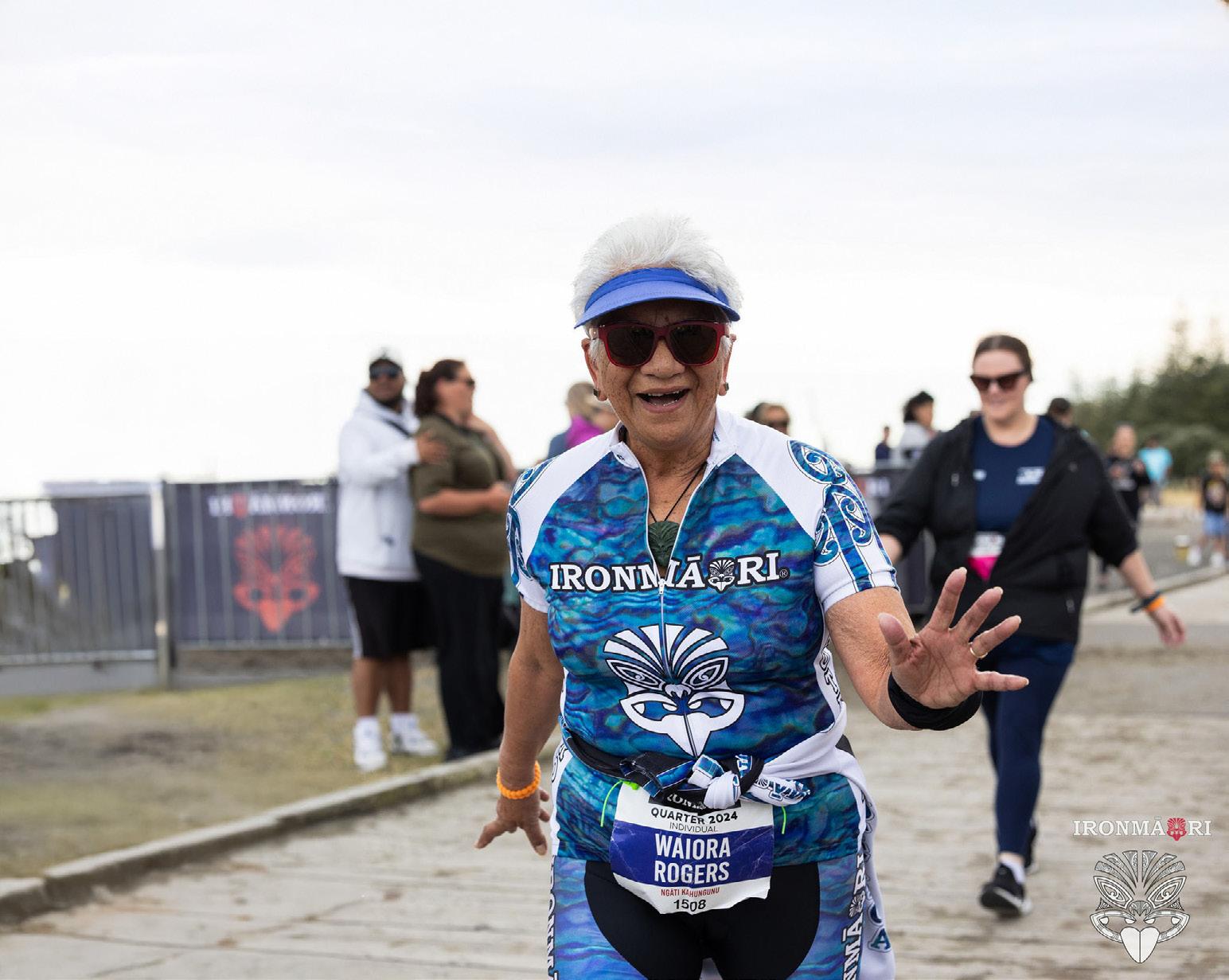



Better sleep starts right here — with local advice you can trust.
At Bedpost, we believe every great day begins with a great night’s sleep — and here in Hawke’s Bay, we’re proud to help our community rest well. Whether you’re a busy parent, a weekend warrior, or just long overdue for a sleep upgrade, we’re here to help you wake up feeling your best.
For over 26 years, we’ve partnered with trusted brands like Sleepmaker, Design Mobel, and Beautyrest to deliver high-quality beds and mattresses that fit real lives and real homes. Our team is passionate about helping you find the right bed for you — because your sleep matters to us.
And when it comes to local expertise, Michael at Bedpost Hawke’s Bay is your go-to guy. He listens. He gets it. Whether you’re working with a budget, planning for a guest room, or finally choosing a bed that supports your lifestyle, Michael will guide you to the right choice without pressure or confusion.
Right now, we’re keeping our showroom fresh with rotating stock and showroom models at incredible prices. It’s the perfect time to stop by, test out our most popular beds, and chat with Michael about what’s best for your sleep style.
So if you’re ready to wake up well, come visit us. Premium brands, honest service, and a better night’s sleep — all waiting for you at Bedpost Hawke’s Bay.
Bedpost Hawkes Bay
44 Dickens street Napier 06 211 3971



Wine / Yvonne Lorkin

You’ve no doubt heard of the Ice Queen, and you’ve possibly heard of the Queen of Darkness, but you may not know that right here in Hawke’s Bay we have our own Queen of Redness. She’s Jenny Dobson.
Photos by Florence Charvin
It’s a well-deserved, monarch-like moniker following her legendary achievements making fine reds in Burgundy and Bordeaux from the late 1970s before moving back to New Zealand in 1996. Upon arriving in Hawke’s Bay, she immediately became a wine consultant to the region’s heavy hitters of the time and cemented herself as serious talent amongst the tanks and barrels.
She also rapidly gained a reputation for being one of the most eloquent, searingly expressive, passionate and authoritative people to host wine tastings and wine education workshops in all ye olde New Zealand.
I first became aware of her when I relocated back home to Hastings in 1998, determined to carve a career in wine myself. I think at the time she was making outstanding reds for husband and wife team Bruce and AnnaBarbara Helliwell at Unison Vineyards in the Gimblett Gravels. I was told she’d arrived fresh from 10 years at Bordeaux Cru Bourgeois Chateau Senejac where she was Bordeaux’s very first female Maitre de Chais (a title that encompasses the roles of cellar master and assistant winemaker). I was also told she was a tornado incapable of turning out an average wine.
It all turned out to be true and now, 27 years later, she’s increased her influence, expanded her portfolio and is happily running her own brand.
So in true Lorkin fashion, I made a nuisance of myself, pestering her with questions smack bang in the middle of a roaringly frantic 2025 grape harvest about how her incredible career began?
“I was born in Mangakino, where my father was a civil engineer working on the Waikato Hydro Schemes and my mother was a school teacher.” Her dad moved to the Waitaki Hydro schemes, so Jenny ended up at high school in Timaru and studying science at Otago University. She shifted to food science and, because of her fascination with all things aromatic, “I did toy for half a second about working in the perfume industry,” opted for wine-related topics for assignments.
So, in 1978, as soon as her degree was dusted, she high-tailed it to Burgundy to learn how to make wine. “I had book and chemistry knowledge before going to France, but my real learning started there,” she says. “And moving to France wasn’t a culture shock, it was a culture joy. I loved the food, the wine, everything.”
Arriving in Burgundy in 1979, she
launched straight into a couple of years working with Jacques Seysses at Domaine Dujac in the cellar and vineyard before moving to Paris to work with the late, great British wine expert Steven Spurrier, developing her tasting skills and teaching wine-appreciation courses. Around this time, she also met her husband Charles (a British wine merchant) at a tasting and that’s when her wine world really began to spin.
You see in 1983, Jenny said “Yes” to becoming the cellar master, or Maître de Chais, at Chateau Sénéjac in the Haut Médoc, the first woman to ever hold such a position in the Bordeaux. It was while working there that she had her three children, Christopher, Richard and Emma, and here’s where we shift into a Q&A…
YL: Winemaking is a demanding job and particularly intense at harvest time. As a mother how did you make it work?
JD: While in France we lived ‘on site’. Our house was just across the courtyard from the winery and the vineyard was around us. My walk to work was 40 meters.
My maternity leave was the days I spent in hospital after the babies were
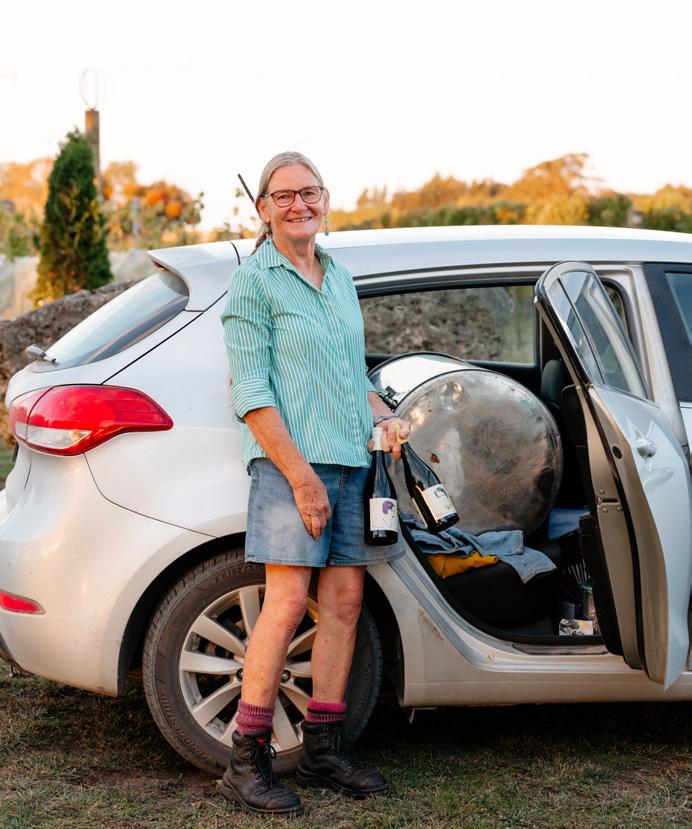
born. I would not have been able to keep my job had I taken maternity leave, maternity cover did not exist. Christopher was born in February of 1987, but Richard arrived in July of 1990 so was just weeks old when vintage came around in September. He was breast fed in the vineyard and winery. Emma was born in April 1994 so the poor girl hasn’t had me around for her birthday since we left France!
But my employer was supportive, and my babies came to work with me. I had a large English pram which they slept in, and a playpen so they could see me working and I could see them. They were well rugged up as the cellar was cool. I don’t think it’s any different to children brought up on a farm where the mother is an integral part of the business. That’s what kept me focused when I felt overwhelmed with winery work, demanding children and a house to run. I was only doing what hundreds of New Zealand mothers had done in the past. You must keep strong and keep fighting forward.
My parents spent several stints with us and helped with childcare and we also had several ‘au pairs’ who were
usually daughters of friends who wanted to spend some time living in France. Preschool in France starts when children are two, so I usually only had one baby with me at a time. They went to and from school on the school bus, which they caught from the Chateau gate. After school they’d join me in the cellar until I finished work. We didn’t have TV, and it was very busy and hectic, but at least I didn’t have far to go to work.
YL: What is your favourite memory of working in Bordeaux?
JD: I’m so appreciative of the opportunity I had to taste the ‘Bordeaux Primeur’ from the top Chateau. Bordeaux Primeur tasting and offerings worked a little differently in the 1980s in that they weren’t as ‘public’ as today. My husband worked for a Bordeaux Negociant who bought wines ‘en Primeur’ which means before they’d normally be available for sale to the public. Samples were delivered to his office and he’d bring them home for me to taste. I learned what great wines should taste like when young, and how to judge their future greatness.

Another great memory was working with Denis Dubourdieu, a winemaker, researcher and a professor at Bordeaux University. I helped him prepare a presentation for the Australian Wine Technical Conference on the art of blending. Chateau Lynch Bages kept individual reference barrels of the grape varieties they used in their wine – Merlot, Cabernet Sauvignon, Cabernet Franc, and Petit Verdot – and we spent several sessions tasting these wines while I helped Denis express his thoughts in English. I learnt so much about all aspects of wine during the time we spent together.
YL: Was relocating to Hawke’s Bay in 1996 exciting or daunting for you?
JD: Daunting. I knew about making wine in France and had built up 13 years’ experience working with the same vineyard in the Haut Medoc, but moving to New Zealand was like starting again. Nothing was the same. It was almost a bigger culture shock moving back to NZ than moving to France! Seeing the children was harder after moving home as I really did ‘go to work’, rather than across the


courtyard. And I was away all day, so only saw them morning and night. It was exciting though because winemaking in France is governed by a restrictive set of rules that often frustrated me. Rules which don’t exist in New Zealand. It’s a much freer environment to craft wine.
YL: Who was your first job with when you moved here? And who have you worked for since?
JD: I started working as a consultant/ contract wine maker. My major client was Sacred Hill Winery. I’m currently working with Squawking Magpie, Unison and William Murdoch wines, but I’ve also had consultancy roles with Te Awa Farm, The Wine Portfolio, Linden Estate, Waimarama Estate and Askerne.
YL: You’re the only Kiwi making Fiano (an Italian white grape from Campania). How did you become involved with growing Fiano in Hawke’s Bay?
JD: I’d tasted Fiano in Europe and thought what an exciting wine! I felt it’d be great to have more diversity in our white wines, so I did some research
and became convinced it’d grow well in Hawke’s Bay. Plus, it’s easy to pronounce! In 2009, Bridge Pa-based grower Bryce Campbell was keen to plant something new and I boldly suggested Fiano. I didn’t think too much about it until a year later when Bryce said he’d been able to source some vines from Riversun Nursery in Gisborne. They’d imported the Fiano for another local winery who’d decided against planting them, so the cuttings were available. Then, in 2015, Bryce offered me the lease of the Fiano vineyard and I become a winegrower.
YL: What is it about Fiano that really grips you?
JD: I love everything about Fiano. Its rich history, the way it grows, the taste of the wine and how well it marries with food. It’s layered with aromas of the red apple, fresh hazelnut, pink grapefruit and has slately mineral note while young. These aromas lean to honeysuckle, roasted hazelnut and citrus rind as it ages. The wine has power, texture, freshness and flavours that linger on the palate. It’s a perfect food wine that ages deliciously in bottle.
“Moving to France wasn’t a culture shock, it was a culture joy. I loved the food, the wine, everything.”
FAR LEFT: “My car is my office. I have a tank in the back seat, vintage gear, my computer, equipment, tools, my files –everything!” Jenny laughs.
CENTRE: The current range from Jenny Dobson Wines.
THIS PAGE: Charles and Jenny with Sylvain oak heads and staves.
Researching its history also led to learning more about the 2nd NZ Division’s Italian Campaign during WWII. They landed in Taranto and moved north to Trieste. They’d have passed through Fiano’s native region on their way to Naples and for many of the NZ soldiers this would’ve been their first encounter with vineyards and wine drinking culture.
YL: Your husband imports and distributes French oak barrels, tell me about that.
JD: I knew of Tonnellerie Sylvain by reputation while working in Bordeaux and Charles, who worked as a negociant, often tasted wine from Sylvain barrels. Their barrels were highly sought after but weren’t widely available, however they were considering expanding into Oceania. Their Sales Director knew we were moving to the Southern Hemisphere and as our principles aligned it was perfect timing, and we’ve been representing Famille Sylvain in NZ ever since. Charles is the main driver of the business, but I enjoy accompanying him when he’s visiting clients, I love
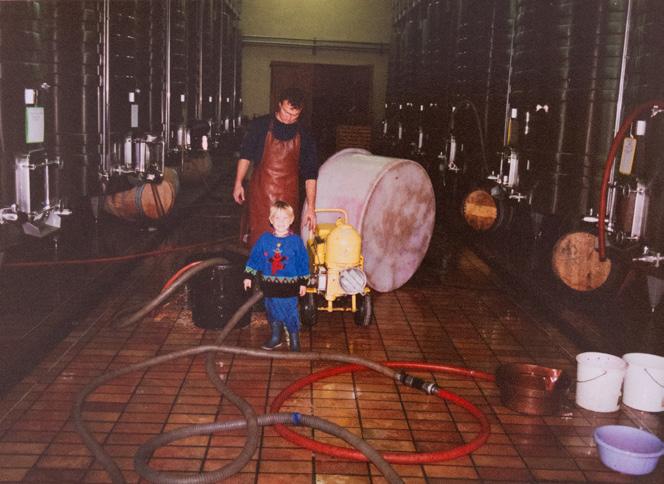
chatting with other winemakers, sharing experiences and being inspired by the wines they are making. The barrel business keeps us connected with France and the French wine industry. Charlie does all his business with France in French, and I get the opportunity to speak a bit of French every now and then.

YL: Finally, has there been a moment that you consider an absolute career highlight?
JD: Definitely the 6th Annual Raffles Wine and Food Experience, ‘Celebrating Ladies of Epicurean Style’, in 2000. I was invited to be one of the all-women guest presenters (international chefs, ten winemakers,
a Parmigiano maker, Serena Sutcliffe MW and Laetizia Riedel of Riedel glasses) for a 5-day food and wine extravaganza where we stayed in the absolute luxury of Raffles Hotel and the week was filled with cooking demonstrations, tutoring wine tastings, Parmigiano appreciation and elaborate lunches and dinners.
I presented Te Awa Farm wines, which tasted amazing, and I was very proud to show our world class wines in such a prestigious event. The finale was ‘The Perfect Pearls of Nature’ Dom Perignon Reception and Caviar Gala Dinner where 7 courses featuring caviar were paired with vintage Dom Perignon. I wrote my tasting notes and food commentaries all over my very elegant menu and still have it. I had a blast and my memory of the week will stay with me forever! Truly a once in a lifetime event.
winebyjennydobson.co.nz
Yvonne Lorkin is a wine writer, the Co-Founder and CTO of WineFriend (NZ’s No.1 personalised wine subscription service) and she’s a proud, born and bred Hawkesbaylien. winefriend.co.nz or yvonnelorkin.com




Life Food / Ian Thomas
It’s the farmyard ménage à trois: Sultry oozing egg yolk married with a salty, crisp rasher, pressed into the enticing embrace of a fresh bun.
The trio of temptation, textural and flavourful perfection, an unqualified triumph, made more so in our household by the knowledge we made it ourselves, from scratch. As we smugly munch our brunch, we garner extra pleasure by delighting in the realisation that as close as we can we are real gate to plate, field to table, farm to fork foodies.
This is how to make a bacon and egg sandwich in under six months. It’s The Good Life in reel form rather than a multi-season episodic epic: here’s a few snapshots from our instagram feed.
We make the bread
Our current, and most enduring, phase of bread-making centres around the forgiving focaccia. It matters not whether you’re in for 100% hydration or prefer a crispier 70%. Whether it’s a slow-rise, gently warmed overnighter or a two-and-a-half-hour hotand-steamy quickie, our pane Italiano brings a rustic Tuscan fieldhand element that always goes down well. If I were a dough I would love to be this flexible. Not needing to be kneaded is a wholesome aspiration. Focaccia is the utilitarian of the bread brigade. If, like me, you cannot be arsed making sourdough then this is the bread for you. I’m not sure I want to put my jaw muscles through the exercise of another sourdough roll anyway. As one gets older masticating becomes more of a chore. Our house special is a litre of water to a kilo of flour (80% high grade and 20% wholemeal), a good slosh of decent EVOO, salt and yeast.
We collect the eggs
Our flock began with a hen we named Teapot and her four small dependents, two of which are roosters and so no longer live with us in suburbia but instead in bucolic settings where their choral
expressions are tolerated if not appreciated. Their sisters, Biscuit and Piano (I’m not on the naming working group), lay small- to medium-sized blue eggs most days. Linda and Jools are the serious egg-laying hybrids, whose presence facilitates cake baking. We buy layer pellets to feed them all ad-lib via a feeder that has a step the hens stand on, which – through a lever mechanism –opens the lid allowing them to eat willynilly, whenever peckish. They are confined to a run, but we do allow them evening tours of the garden.
We raise the pigs
Our baconers live an idyllic country life. They sport nasal piercings reminiscent of a competent barista, and grunt just as coherently. Roaming their large grassy enclosure from morning til dusk, feeding on apples, grass and food-prep scraps, these Berkshires are covered mostly with black hair and frequently with mud. They’re not a commercial breed so grow slowly and produce a vastly superior meat. I’ve kept pigs on and off for over thirty years and these beauties are the best we’ve ever raised. Over the decades I’ve killed my pigs on-farm and processed them into a variety of smallgoods, including the delicious biraldo blood sausage. Even the average pig’s intelligence and friendliness mean I no longer want to be involved in that part of the operation. The excellent folk at Wild Game Salamis do the work and we simply enjoy the result. Back-in-the-day Holly Bacon would handle the off-farm swine but no longer. We are fortunate in Hastings to boast two of the very best bacon makers and it’s worth seeking them out.
The word bacon shares etymology with the word back, which indicates where on the carcass bacon comes from. Side note: the Italian for stomach is pancia, which indicates where pancetta comes from.
For our home-grown sandwich we are using middle bacon, which if we

ate the beast fresh would be a chop. Smoked, brined and air-dried bacon is a treasure. Clarify in your mind the importance of bacon by imagining a world without bacon. My apologies, it doesn’t bear thinking about.
We assemble the sarnie
In recent years the sandwich has experienced a super-sizing transformation but we keep things old-school. I like to cook bacon in the oven until just crisp. Eggs must be fresh, cracked into a pan with oil and melted butter at a low heat. Think poaching in oil or butter rather than vigorous frying; call it froaching. Butter the bread, lay down your bacon, squeeze a little ketchup and top with your egg. The yolk – indisputably nature’s finest sauce – must be runny so dress appropriately because you’re going to get squirted. Add a few drops of hot sauce, butter the lid and devour it! Do not nibble. This is no time to be half-hearted. Just because it took six months to make doesn’t mean it can’t take 60 seconds to eat.
We sit in the sun with self-satisfied smiles. The sandwich is now nothing but a smear of yolk on the plate and a wonderful memory, ideally accompanied by coffee and a comfortable seat under an umbrella in the Hawke’s Bay sun.
No we didn’t grow the wheat, or grind the flour, or raise the cows for the cream to make the butter. Yes, Wattie’s made the ketchup. But we’re still delighted by our own B&E sammie and our ongoing fascination with gigolo bread and aging hens. We’re not real farmers, we don’t have to weather the storms of meteorology, money and trade, but we are closer to nature than before.
Ian Thomas is a caterer and formerly free range egg farmer, cooking demonstrator, and manager of a commercial food production business. He specialises in cooking paella. paellaagogo.com
Photo: Florence Charvin

What does it take to live a long, vibrant life?
Ask the experts, and they’ll mention things like nutrition, sleep, and social connection. But increasingly, science is shining a spotlight on something many women still overlook – the strength of functional movement.
Research shows that maintaining muscle mass and mobility is one of the most powerful predictors of longevity, especially for women. This is training that isn’t just about looking fit – it’s about preventing falls, supporting joint health, improving balance, and staying independent as we age. And functional movement – the kind that mimics everyday tasks like bending, squatting, reaching, or walking – can make the difference between simply aging … and aging well.
But sometimes the most compelling insights don’t come from data. They come from people living the evidence every day.
Meet Ainslie Reid, a 90-year-old woman whose life is a masterclass in active aging. Whether she’s walking her local estuary, stretching into a gentle yoga pose, or tending to her garden, her lifestyle reminds us that vitality doesn’t vanish with age – it just evolves.
“I was brought up on the West Coast,” she tells me, “and because my mother didn’t drive, we walked or biked everywhere, often in the pouring rain.” Her mother had a knack for good posture too, constantly reminding her to stand tall, shoulders back,

toes turned out. “I hated it then,” she laughs, “but I’m grateful for her perseverance now.”
That early foundation of movement never left her. Today, Ainslie walks daily – regularly taking on the local hills in Napier, sometimes enjoying flatter paths around the estuary. “I do most of my own housework and gardening. I have someone to help with the floors now, because of arthritis, but staying active is still important to me.”
She’s also been doing yoga on and off for over 20 years. “Now I love the gentle Yin Yoga. I’m more cautious these days and definitely aware that my energy isn’t what it used to be, but I still do what I can.”
Her body, like anyone’s, has weathered a few storms. She broke her
kneecap 13 years ago and dealt with serious back pain in her mid-50s. But she kept going. “I think attitude is half the battle,” she says. “You just need to stay within your capabilities.”
And it’s that mindset – self-awareness mixed with quiet discipline – that seems to define her strength.
“I’ve only ever been to the gym once,” she admits, “but I’ve always moved. I started tramping once my family were teenagers and only gave it up about seven years ago.” In her 50s, she went trekking in Nepal and Kashmir with Lady June Hillary – a five-week adventure through mountain ranges, culture, and courage.
But even at home, strength has played a vital role in her independence. “Living on my own, I’m motivated by the simple fact that ‘it’s up to me’. If I’m feeling
“It’s never too late to create a new habit to help yourself. Keep moving, stay positive, and don’t underestimate the small things.”
Ainslie Reid
down, I make plans – coffee with a friend, a movie, something to look forward to.”
That proactive spirit has been key, especially given her family history.
“There’s depression in my background, so I’m very aware of not letting myself fall into a black hole. If I need to, I let myself feel ‘yuck’ for a bit, but then I pick myself up. A Gratitude Book helps. So does surrounding myself with positive people.”
She’s quick to emphasize that staying well doesn’t require anything extreme. “It doesn’t have to be a major activity. A walk, fresh air, a good sleep, nourishing food – those are the things that help. I’m no different from hundreds of other amazing older people just trying to live the best life they can.”
Her advice for younger women is simple but powerful: “It’s never too late to create a new habit to help yourself. Keep moving, stay positive, and don’t underestimate the small things.”
And while she’s full of appreciation for what her body can still do, she’s also still dreaming. “I’d love to go on a balloon flight. And a jet boat ride into Fiordland; that’s on my list.”
A life that moves us
In Ainslie’s story, we find more than a tale of graceful aging. We find a gentle challenge – to rethink what’s possible as we age, and to realise how much of it is in our hands.
Science can tell us that women who build strength are less likely to suffer fractures, chronic pain, or mobility issues. But it’s women like Ainslie who show us what those outcomes look like in real life – long walks, yoga stretches, solo living, everyday independence, and a heart still full of curiosity.
She reminds us that longevity isn’t just about the years in your life, but the life in your years.
So to every woman wondering if it’s
You’re in great hands
Royston’s team of leading Gastrointestinal specialists use the most advanced endoscopy technology for gastroscopy & colonoscopy procedures to provide you with the very best care.
Along with our highly skilled endoscopy nurses, Royston now provides a Capsule Endoscopy service (a pain-free and efficient pill you swallow which takes video images of the gastrointestinal tract), an advanced non-invasive procedure to support highly accurate, fast and convenient diagnosis of gastrointestinal conditions.
royston.co.nz Evolution Healthcare
too late to get stronger, move more, or build a habit that supports her health: start today. Be inspired by women like Ainslie. And know that your body is worth looking after, at every stage of life. Because strength doesn’t have to fade with age. It’s something we carry, build, and reclaim, one step at a time.
Janine Couchman is a personal trainer and fitness coach specialising in strength training women of all ages and stages. As well as private coaching, she delivers an eight-week group programme at Peak Fitness and Health. She can be found at janinecouchman.com and @JaninecouchmanPT

Royston Hospital is pleased to sponsor robust examination of health issues in Hawke’s Bay. This reporting is prepared by BayBuzz. Any editorial views expressed are those of the BayBuzz team.





Dr Ana Braithwaite
Endoscopy
Gastroenterology
021 225 2535 ana.braithwaite@royston.co.nz
Dr Ariel Drori
Endoscopy
Gastroenterology 021 467 674 info@drorimedical.co.nz
Mr Grant Broadhurst
Endoscopy
General Surgery 06 873 8007 contact@baysurgical.co.nz
Dr John Wyeth
Endoscopy
Gastroenterology 04 479 8261 endo@bowen.co.nz
Mr Bertrand Jauffret
Endoscopy
General Surgery 021 867 117 reception@medspecialists.nz
It’s a myth that we only use 10% of our brain power. We use all of it, but 90% is used solely for trivia. Ten percent is for useful things like where you put your car keys and what your IRD number is. Ninety percent is reserved for the capital of Burkina Faso, the winner of the 2019 FA cup final, NZ’s longest serving PM and the size of Loch Ness in cubic metres.
Whether it’s Stuff-quiz-at-10am or firstTuesday-of-every-month chances are you like to get your quiz on. Most of us do. It’s a party trick, knowing what’s special about ruthenium, or what there are 336 of in golf or what the macguffin in Pulp Fiction is. It’s a great way to start a conversation, or a great way to pull a hand-break turn on a conversation that’s going south. Don’t want to discuss your sister’s divorce any longer? Wow people with facts about Violet Jessop who survived three ship sinkings in as many years. It’s a fun approach to finishing up an endless meeting, making reference to the Chabad-Lubavitch Shluchim. And it’s a way to get a wayward chat back on track. Pop-quiz: who met Stalin at the Yalta Resort in 1945?
There’s a big difference between trivia and general knowledge. General knowledge is knowing that there are 366 days in a leap year. Trivia is knowing leap years were introduced by Julius Caesar. General knowledge is knowing the funny bone is near the humerus. Trivia is knowing the funny bone isn’t actually a bone. General knowledge is knowing B is Bravo in the NATO phonetic alphabet. Trivia is knowing Bravo Zulu is shorthand for “good job/well done”.
Samuel Johnson, the great English writer and lit-crit, said of general knowledge that it was “a store of learning, acquired by reading and
conversation, respecting history, science, and art, general manners and customs”. Fun fact about Johnson: he suffered from Tourette’s and married a woman twice his age (not necessarily in that order).
Knowledge is useful. Not like trivia, which sticks to your synapses like gum to a shoe, whether you like it or not, with no respect for science, art or general manners.
That’s why pub quizzes are so popular. They are a cathartic release from the annoyance of having trivia clogging up your neural pathways … a group vomit brought about by the debauchery of consuming useless facts, like Romans at a cerebral orgy devouring nonsense then purging, collectively. Interesting trivia about Romans: they used mouse-brains as toothpaste and urine for washing clothes.
The secret to success on the pub quiz circuit is getting together the right team. It’s tempting to stack it with brainiacs but if they’re boring it’ll be a long night just to win a $50 bar tab. Better to find a tight pack you enjoy drinking with then throw in a quiz to keep things moving.
To be successful you’ll need to cover a few bases. You’ll want someone who understands sport and someone who has travelled further than Australia, someone who keeps up with world news and someone who is younger than 30. And you’ll need an English teacher or a librarian. Fun fact: Mao Zedong and Lewis Carroll were both librarians.
To actually win a quiz you have to know all the answers, and that’s much more to do with luck than IQ. Maybe you happened to spend six months WWOOFing in Split then you’ll know, if asked, which coastline it’s on, and if you like dalmatians then you’ll know how Glen Close is linked to Emma Stone, and if you really love Emma Stone you’ll know which three films

Yorgos Lanthimos cast her in, and if you know that maybe you know who the first film was based on as recorded by Winston Churchill who was the greatgreat- great- grand-something-or-other of her lover Sarah, and if you know about Churchill maybe you know who he met in Yalta in 1945. Just knowing that might win you a bonus round for which you’d double your points. But that’s a lot of ‘ifs’ and ‘maybes’.
The human brain has a storage capacity of 2.5 petabytes or 2.5 million gigabytes. If you had a 2.5-petabyte hard drive it could hold 500,000 movies or 600 million songs (you’d have to choose). Which is why if you know more than a dozen weird facts about entomology, you probably can’t remember your IRD number.
If we’re not quizzing to win, why do it? Rifling through grey-matter gigabytes and finding just what we’re looking for gives us a hit of dopamine, which boosts motivation, learning and the formation of memories, which makes us better quizzers. We quiz because we can… Cogito, Ergo Sum. Obscure fact about Rene ‘I think therefore I am’ Descartes: He’s also the guy who first thought up X to represent the unknown. And maybe it’s the X that keeps us quizzing, the knowledge that there’s always one more piece of the unknown left to conquer.
Cruella De Vil; The Favorite, Poor Things and Kinds of Kindness; Queen Anne.
Answers: Ouagadougou; Man. City; Seddon; 7,452 million; Shiny as tin foil; Dimples on the ball; Suitcase full of gold; Olympic, Titanic and Brittanic; Longest Zoom meeting; Churchill and Stalin met with Roosevelt in Yalta; Dalmatian Coast; They both played
Sponsored by Little Red Robot

levers, pushing buttons and making machines work - kids and adults alike love the fascinating Faraday experience.
biplane hanging from the ceiling

Our Hawke’s Bay wealth management experts will work with you to guide you toward your long-term financial goals. www.jarden.co.nz/wealth-management
